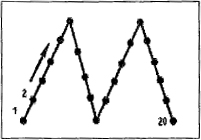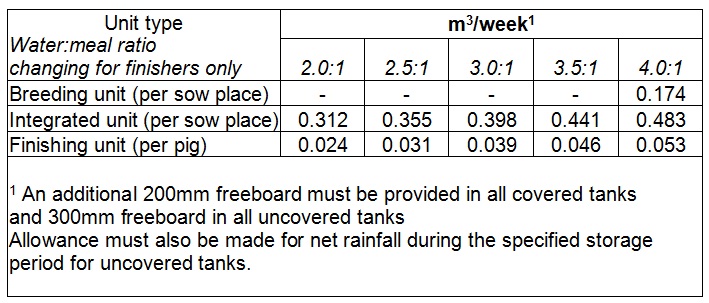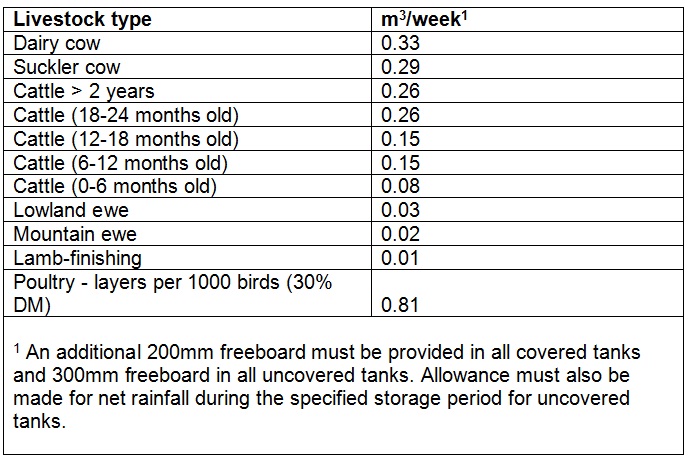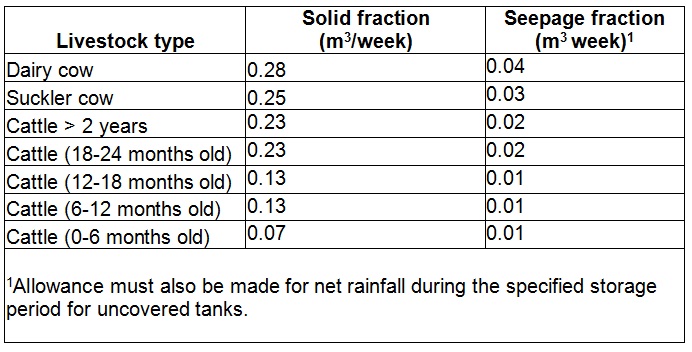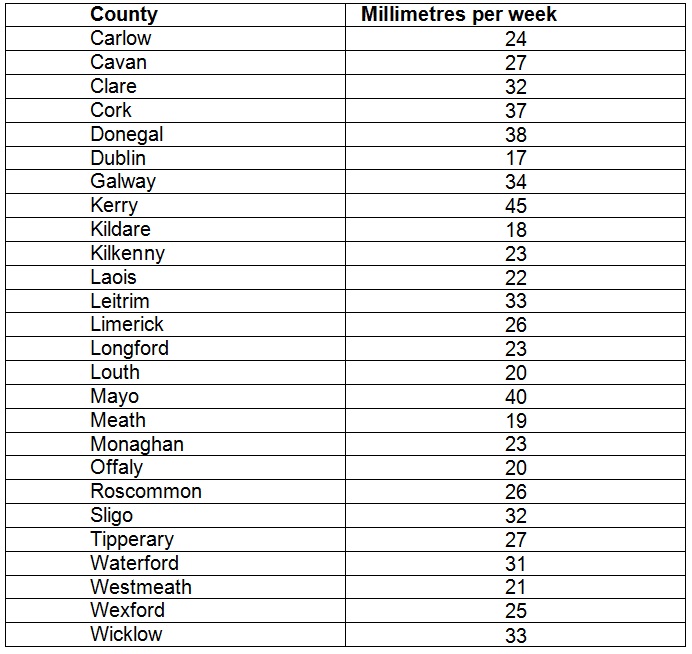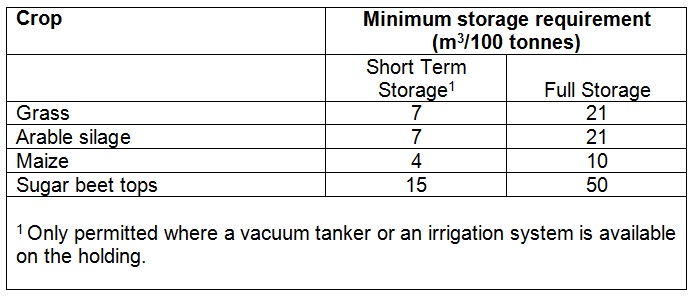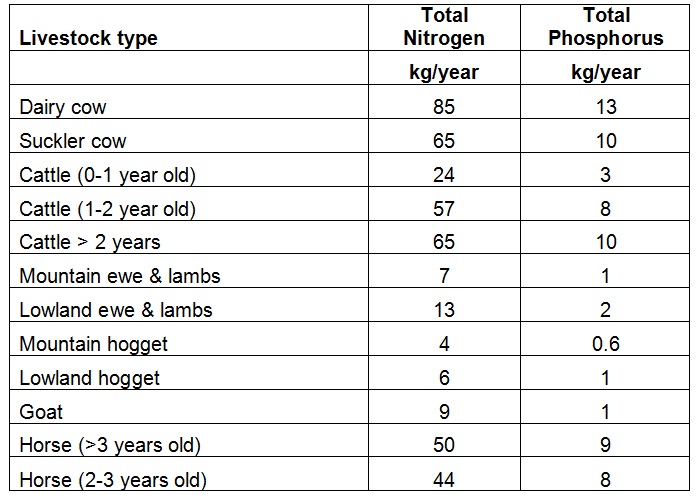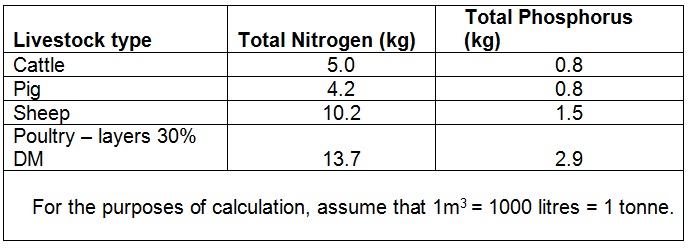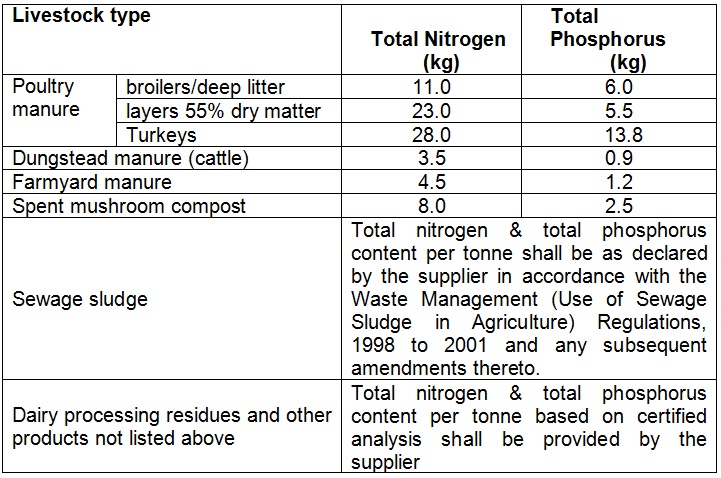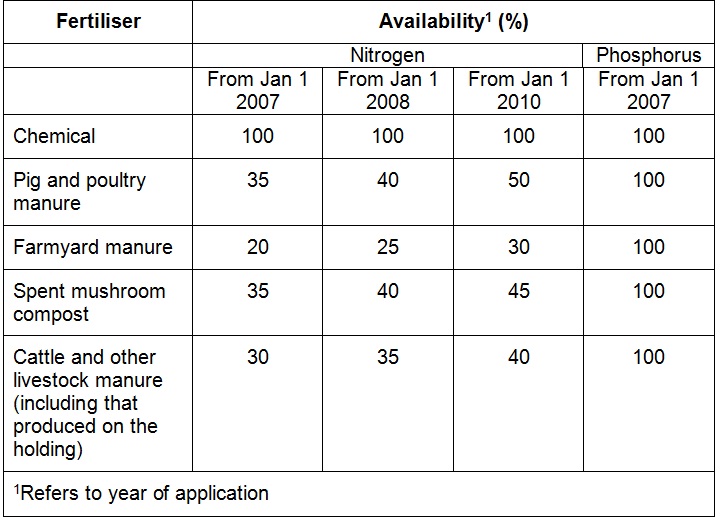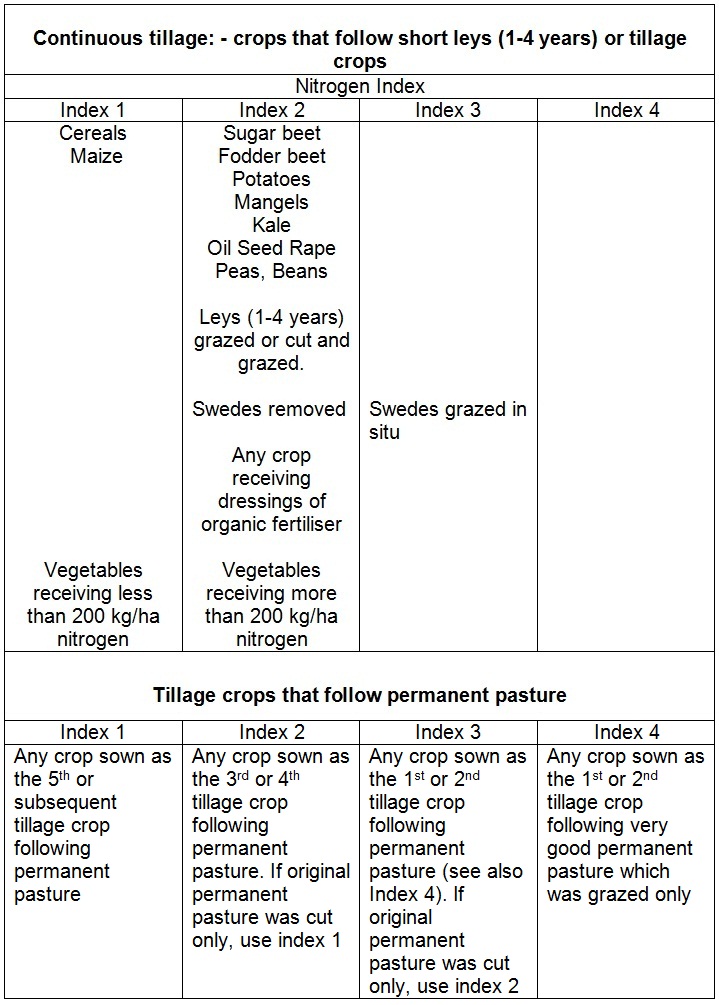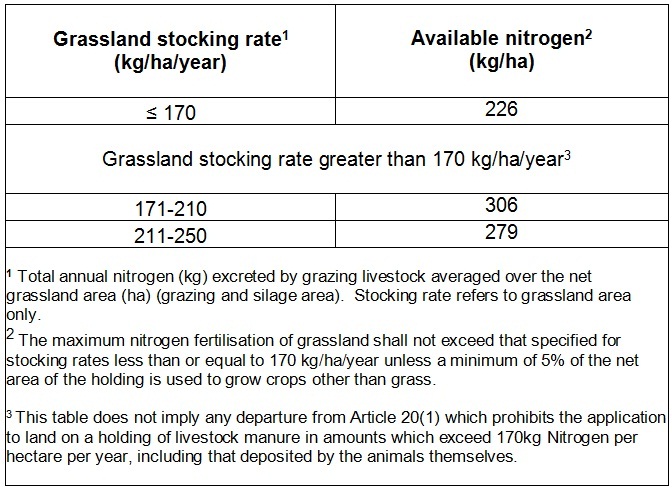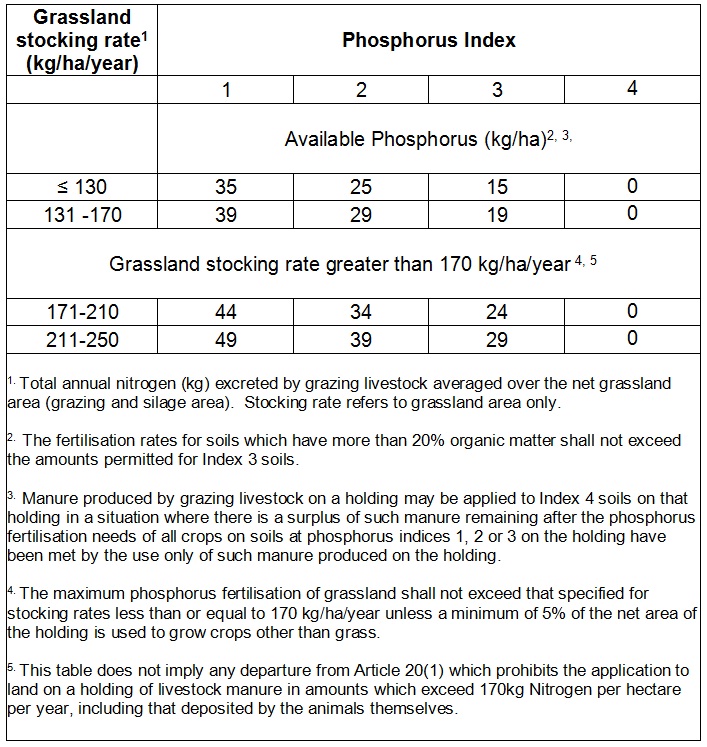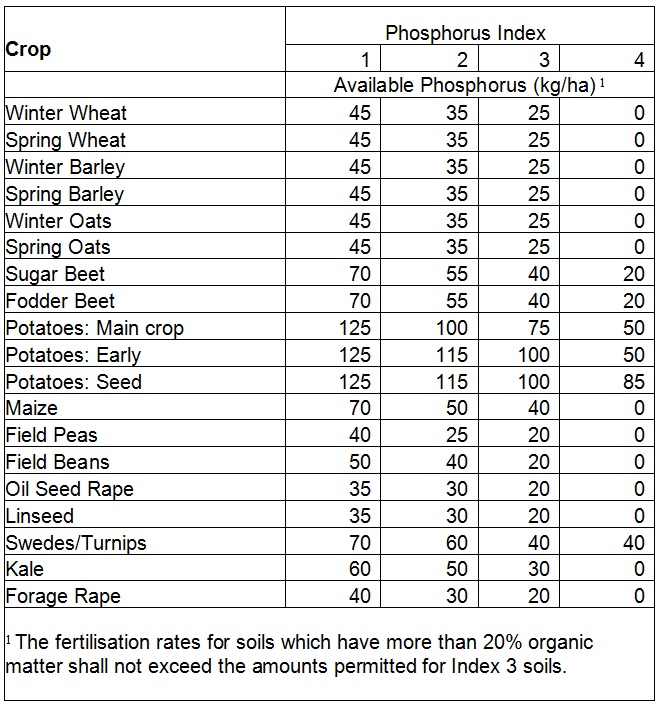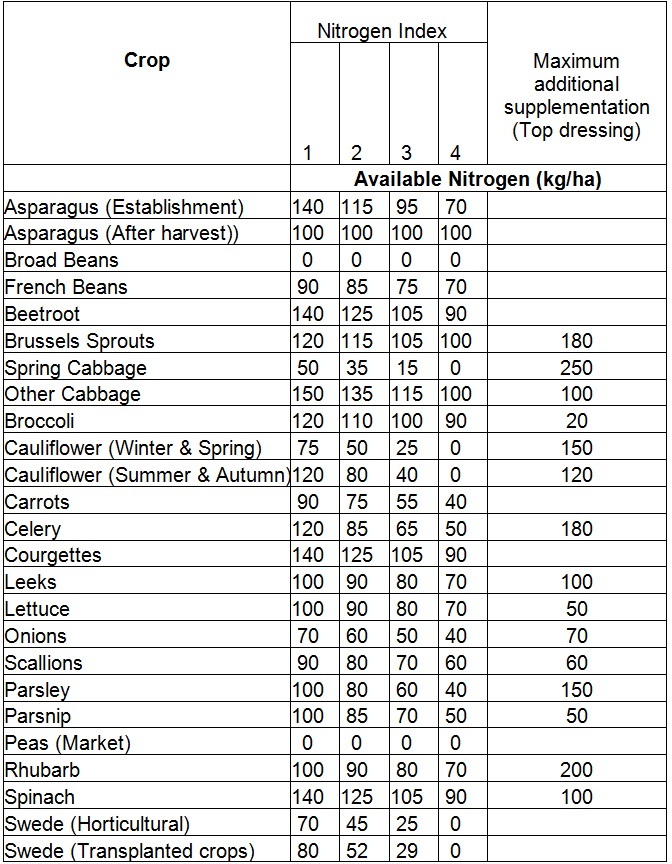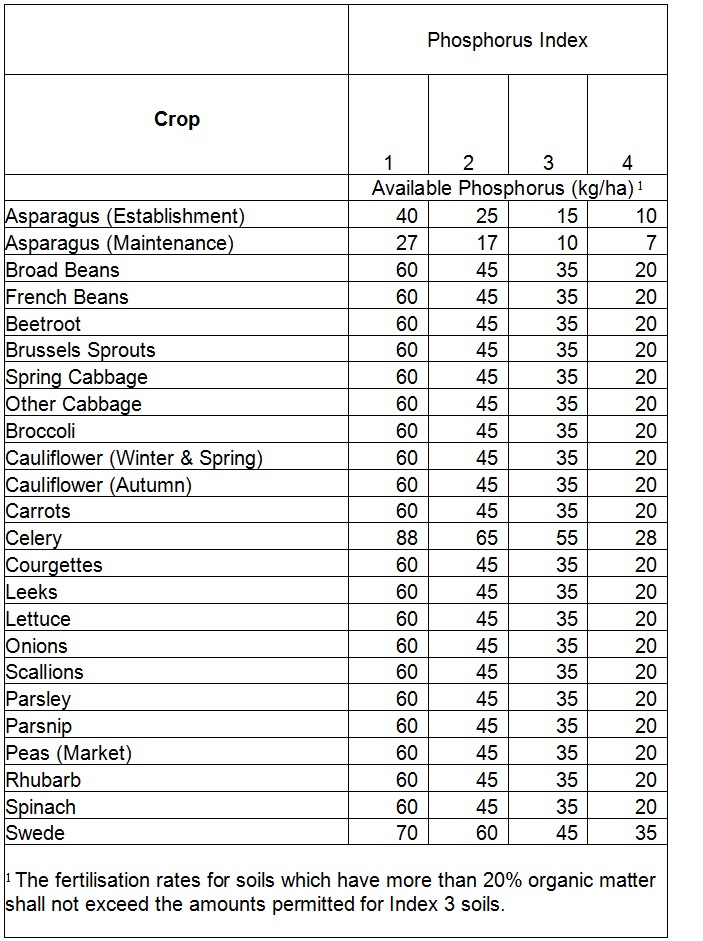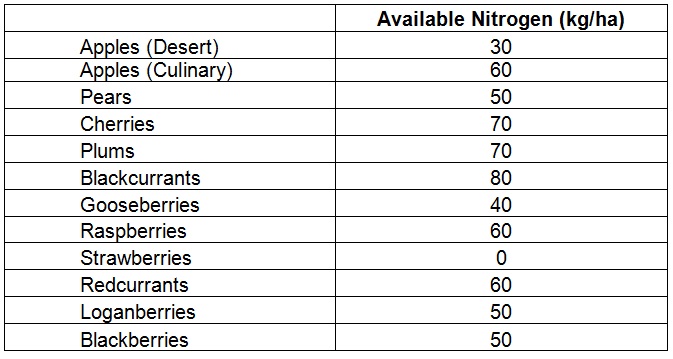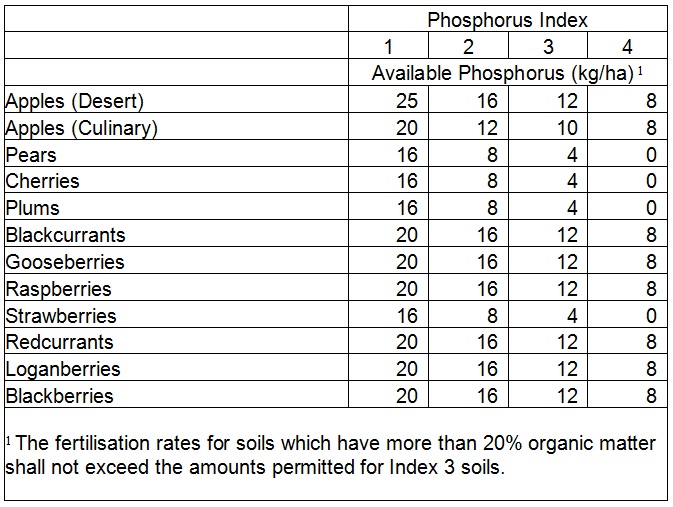S.I. No. 378/2006 - European Communities (Good Agricultural Practice for Protection of Waters) Regulations 2006
STATUTORY INSTRUMENTS | ||||||||||||||||||||||||||||||||||||||||||||||||||||||||||||||||||||||||||||||||||||||||||||||||||||||||||||||||||||||||||||||||||||||||||||
S.I. No. 378 of 2006 | ||||||||||||||||||||||||||||||||||||||||||||||||||||||||||||||||||||||||||||||||||||||||||||||||||||||||||||||||||||||||||||||||||||||||||||
European Communities (Good Agricultural Practice for Protection of Waters) Regulations 2006 | ||||||||||||||||||||||||||||||||||||||||||||||||||||||||||||||||||||||||||||||||||||||||||||||||||||||||||||||||||||||||||||||||||||||||||||
INDEX | ||||||||||||||||||||||||||||||||||||||||||||||||||||||||||||||||||||||||||||||||||||||||||||||||||||||||||||||||||||||||||||||||||||||||||||
| ||||||||||||||||||||||||||||||||||||||||||||||||||||||||||||||||||||||||||||||||||||||||||||||||||||||||||||||||||||||||||||||||||||||||||||
S.I. No. 378 of 2006 | ||||||||||||||||||||||||||||||||||||||||||||||||||||||||||||||||||||||||||||||||||||||||||||||||||||||||||||||||||||||||||||||||||||||||||||
European Communities (Good Agricultural Practice for Protection of Waters) Regulations 2006 | ||||||||||||||||||||||||||||||||||||||||||||||||||||||||||||||||||||||||||||||||||||||||||||||||||||||||||||||||||||||||||||||||||||||||||||
The Minister for the Environment, Heritage and Local Government in exercise of the powers conferred on him by section 3 of the European Communities Act, 1972 (No. 27 of 1972) and for the purposes of giving further effect to Directive 75/442/EEC of 15 July 19751 , Directive 76/464/EEC of 4 May 19762 , Directive 80/68/EEC of 17 December 19793 Directive 91/676/EEC of 12 December 19914 , Directive 2000/60/EC of 23 October 20005 and Directive 2003/35/EC of 26 May 20036 hereby makes the following Regulations: | ||||||||||||||||||||||||||||||||||||||||||||||||||||||||||||||||||||||||||||||||||||||||||||||||||||||||||||||||||||||||||||||||||||||||||||
|
PART 1 PRELIMINARY | ||||||||||||||||||||||||||||||||||||||||||||||||||||||||||||||||||||||||||||||||||||||||||||||||||||||||||||||||||||||||||||||||||||||||||||
|
Citation and commencement | 1. (a) These Regulations may be cited as the European Communities (Good Agricultural Practice for Protection of Waters) Regulations 2006. | |||||||||||||||||||||||||||||||||||||||||||||||||||||||||||||||||||||||||||||||||||||||||||||||||||||||||||||||||||||||||||||||||||||||||||
(b) These Regulations shall come into effect on 1 August, 2006 save as is otherwise provided in relation to any particular provision. | ||||||||||||||||||||||||||||||||||||||||||||||||||||||||||||||||||||||||||||||||||||||||||||||||||||||||||||||||||||||||||||||||||||||||||||
|
Revocations | 2. The European Communities (Protection of Waters Against Pollution from Agricultural Sources) Regulations, 2003 ( S.I. No.213 of 2003 ) and the European Communities (Good Agricultural Practice for Protection of Waters) Regulations, 2005 ( S.I. No. 788 of 2005 ) are hereby revoked. | |||||||||||||||||||||||||||||||||||||||||||||||||||||||||||||||||||||||||||||||||||||||||||||||||||||||||||||||||||||||||||||||||||||||||||
|
Interpretation | 3. (1) In these Regulations, save where the context otherwise requires - | |||||||||||||||||||||||||||||||||||||||||||||||||||||||||||||||||||||||||||||||||||||||||||||||||||||||||||||||||||||||||||||||||||||||||||
“Act of 1992” means the Environmental Protection Agency Act, 1992 (No. 7 of 1992); | ||||||||||||||||||||||||||||||||||||||||||||||||||||||||||||||||||||||||||||||||||||||||||||||||||||||||||||||||||||||||||||||||||||||||||||
“Agency” means the Environmental Protection Agency established under section 19 of the Act of 1992; | ||||||||||||||||||||||||||||||||||||||||||||||||||||||||||||||||||||||||||||||||||||||||||||||||||||||||||||||||||||||||||||||||||||||||||||
“agriculture” includes the breeding, keeping and sale of livestock (including cattle, horses, pigs, poultry, sheep and any creature kept for the production of food, wool, skins or fur), the making and storage of silage, the cultivation of land, and the growing of crops (including forestry and horticultural crops); | ||||||||||||||||||||||||||||||||||||||||||||||||||||||||||||||||||||||||||||||||||||||||||||||||||||||||||||||||||||||||||||||||||||||||||||
“application to land”, in relation to fertiliser, means the addition of fertiliser to land whether by spreading on the surface of the land, injection into the land, placing below the surface of the land or mixing with the surface layers of the land but does not include the direct deposition of manure to land by animals; | ||||||||||||||||||||||||||||||||||||||||||||||||||||||||||||||||||||||||||||||||||||||||||||||||||||||||||||||||||||||||||||||||||||||||||||
“aquifer” means any stratum or combination of strata that stores or transmits groundwater; | ||||||||||||||||||||||||||||||||||||||||||||||||||||||||||||||||||||||||||||||||||||||||||||||||||||||||||||||||||||||||||||||||||||||||||||
“chemical fertiliser” means any fertiliser that is manufactured by an industrial process; | ||||||||||||||||||||||||||||||||||||||||||||||||||||||||||||||||||||||||||||||||||||||||||||||||||||||||||||||||||||||||||||||||||||||||||||
“farmyard manure” means a mixture of bedding material and animal excreta in solid form arising from the housing of cattle, sheep and other livestock excluding poultry; | ||||||||||||||||||||||||||||||||||||||||||||||||||||||||||||||||||||||||||||||||||||||||||||||||||||||||||||||||||||||||||||||||||||||||||||
“fertiliser” means any substance containing nitrogen or phosphorus or a nitrogen compound or phosphorus compound utilised on land to enhance growth of vegetation and may include livestock manure, the residues from fish farms and sewage sludge; | ||||||||||||||||||||||||||||||||||||||||||||||||||||||||||||||||||||||||||||||||||||||||||||||||||||||||||||||||||||||||||||||||||||||||||||
“groundwater” means all water that is below the surface of the ground in the saturation zone and in direct contact with the ground or subsoil; | ||||||||||||||||||||||||||||||||||||||||||||||||||||||||||||||||||||||||||||||||||||||||||||||||||||||||||||||||||||||||||||||||||||||||||||
“holding” means an agricultural production unit and, in relation to an occupier, means all the agricultural production units managed by that occupier; | ||||||||||||||||||||||||||||||||||||||||||||||||||||||||||||||||||||||||||||||||||||||||||||||||||||||||||||||||||||||||||||||||||||||||||||
“livestock” means all animals kept for use or profit (including cattle, horses, pigs, poultry, sheep and any creature kept for the production of food, wool, skins or fur); | ||||||||||||||||||||||||||||||||||||||||||||||||||||||||||||||||||||||||||||||||||||||||||||||||||||||||||||||||||||||||||||||||||||||||||||
“livestock manure” means waste products excreted by livestock or a mixture of litter and waste products excreted by livestock, even in processed form; | ||||||||||||||||||||||||||||||||||||||||||||||||||||||||||||||||||||||||||||||||||||||||||||||||||||||||||||||||||||||||||||||||||||||||||||
“local authority” means a city council or county council within the meaning of the Local Government Act, 2001 (No.37 of 2001); | ||||||||||||||||||||||||||||||||||||||||||||||||||||||||||||||||||||||||||||||||||||||||||||||||||||||||||||||||||||||||||||||||||||||||||||
“the Minister” means the Minister for the Environment, Heritage and Local Government; | ||||||||||||||||||||||||||||||||||||||||||||||||||||||||||||||||||||||||||||||||||||||||||||||||||||||||||||||||||||||||||||||||||||||||||||
“net area”, in relation to a holding and the grassland stocking rate, means the gross area of the holding or the grassland as appropriate excluding areas under farm roads, paths, buildings, farmyards, woods, dense scrub, rivers, streams, ponds, lakes, sandpits, quarries, expanses of bare rock, areas of bogland not grazed, areas fenced off and not used for production, inaccessible areas and areas of forestry (including Christmas trees), or required to be totally destocked under a Commonage Framework Plan; | ||||||||||||||||||||||||||||||||||||||||||||||||||||||||||||||||||||||||||||||||||||||||||||||||||||||||||||||||||||||||||||||||||||||||||||
“the Nitrates Directive” means Council Directive 91/676/EEC of 12 December 1991 concerning the protection of waters against pollution caused by nitrates from agricultural sources; | ||||||||||||||||||||||||||||||||||||||||||||||||||||||||||||||||||||||||||||||||||||||||||||||||||||||||||||||||||||||||||||||||||||||||||||
“occupier”, in relation to a holding, includes the owner, a lessee, any person entitled to occupy the holding or any other person having for the time being control of the holding; | ||||||||||||||||||||||||||||||||||||||||||||||||||||||||||||||||||||||||||||||||||||||||||||||||||||||||||||||||||||||||||||||||||||||||||||
“organic fertiliser” means any fertiliser other than that manufactured by an industrial process and includes livestock manure, dungstead manure, farmyard manure, slurry, soiled water, non-farm organic substances such as sewage sludge, industrial by-products and sludges and residues from fish farms; | ||||||||||||||||||||||||||||||||||||||||||||||||||||||||||||||||||||||||||||||||||||||||||||||||||||||||||||||||||||||||||||||||||||||||||||
“ploughing” includes ploughing and primary cultivation, excluding light cultivation carried out to encourage natural regeneration; | ||||||||||||||||||||||||||||||||||||||||||||||||||||||||||||||||||||||||||||||||||||||||||||||||||||||||||||||||||||||||||||||||||||||||||||
“relevant local authority” means the local authority in whose administrative area a farm holding or part of a farm holding is situated; | ||||||||||||||||||||||||||||||||||||||||||||||||||||||||||||||||||||||||||||||||||||||||||||||||||||||||||||||||||||||||||||||||||||||||||||
“river basin district” means a river basin district established by the European Communities (Water Policy) Regulations, 2003 ( S.I. No. 722 of 2003 ); | ||||||||||||||||||||||||||||||||||||||||||||||||||||||||||||||||||||||||||||||||||||||||||||||||||||||||||||||||||||||||||||||||||||||||||||
“slurry” includes - | ||||||||||||||||||||||||||||||||||||||||||||||||||||||||||||||||||||||||||||||||||||||||||||||||||||||||||||||||||||||||||||||||||||||||||||
(a) excreta produced by livestock while in a building or yard, and | ||||||||||||||||||||||||||||||||||||||||||||||||||||||||||||||||||||||||||||||||||||||||||||||||||||||||||||||||||||||||||||||||||||||||||||
(b) a mixture of such excreta with rainwater, washings or other extraneous material or any combination of these, | ||||||||||||||||||||||||||||||||||||||||||||||||||||||||||||||||||||||||||||||||||||||||||||||||||||||||||||||||||||||||||||||||||||||||||||
of a consistency that allows it to be pumped or discharged by gravity at any stage in the handling process but does not include soiled water; | ||||||||||||||||||||||||||||||||||||||||||||||||||||||||||||||||||||||||||||||||||||||||||||||||||||||||||||||||||||||||||||||||||||||||||||
“soil test” means a soil sample taken in accordance with the soil sampling procedure set out in Schedule 1 and analysed in accordance with that Schedule, at a laboratory approved for this purpose by the Minister for Agriculture and Food; | ||||||||||||||||||||||||||||||||||||||||||||||||||||||||||||||||||||||||||||||||||||||||||||||||||||||||||||||||||||||||||||||||||||||||||||
“soiled water” has the meaning assigned by sub-article (2); | ||||||||||||||||||||||||||||||||||||||||||||||||||||||||||||||||||||||||||||||||||||||||||||||||||||||||||||||||||||||||||||||||||||||||||||
“steep slope” means ground which has an average incline of 20% or more in the case of grassland or 15% or more in the case of other land; | ||||||||||||||||||||||||||||||||||||||||||||||||||||||||||||||||||||||||||||||||||||||||||||||||||||||||||||||||||||||||||||||||||||||||||||
“tidal waters” includes the sea and any estuary up to high water mark medium tide and any enclosed dock adjoining tidal waters; | ||||||||||||||||||||||||||||||||||||||||||||||||||||||||||||||||||||||||||||||||||||||||||||||||||||||||||||||||||||||||||||||||||||||||||||
“waters” includes - | ||||||||||||||||||||||||||||||||||||||||||||||||||||||||||||||||||||||||||||||||||||||||||||||||||||||||||||||||||||||||||||||||||||||||||||
(a) any (or any part of any) river, stream, lake, canal, reservoir, aquifer, pond, watercourse, or other inland waters, whether natural or artificial, | ||||||||||||||||||||||||||||||||||||||||||||||||||||||||||||||||||||||||||||||||||||||||||||||||||||||||||||||||||||||||||||||||||||||||||||
(b) any tidal waters, and | ||||||||||||||||||||||||||||||||||||||||||||||||||||||||||||||||||||||||||||||||||||||||||||||||||||||||||||||||||||||||||||||||||||||||||||
(c) where the context permits, any beach, river bank and salt marsh or other area which is contiguous to anything mentioned in paragraph (a) or (b), and the channel or bed of anything mentioned in paragraph (a) which is for the time being dry, | ||||||||||||||||||||||||||||||||||||||||||||||||||||||||||||||||||||||||||||||||||||||||||||||||||||||||||||||||||||||||||||||||||||||||||||
but does not include a sewer, | ||||||||||||||||||||||||||||||||||||||||||||||||||||||||||||||||||||||||||||||||||||||||||||||||||||||||||||||||||||||||||||||||||||||||||||
“waterlogged ground” means ground that is saturated with water such that any further addition will lead, or is likely to lead, to surface run-off; | ||||||||||||||||||||||||||||||||||||||||||||||||||||||||||||||||||||||||||||||||||||||||||||||||||||||||||||||||||||||||||||||||||||||||||||
and cognate words shall be construed accordingly. | ||||||||||||||||||||||||||||||||||||||||||||||||||||||||||||||||||||||||||||||||||||||||||||||||||||||||||||||||||||||||||||||||||||||||||||
(2) (a) In these Regulations “soiled water” includes, subject to this sub-article, water from concreted areas, hard standing areas, holding areas for livestock and other farmyard areas where such water is contaminated by contact with any of the following substances - | ||||||||||||||||||||||||||||||||||||||||||||||||||||||||||||||||||||||||||||||||||||||||||||||||||||||||||||||||||||||||||||||||||||||||||||
(i) livestock faeces or urine or silage effluent, | ||||||||||||||||||||||||||||||||||||||||||||||||||||||||||||||||||||||||||||||||||||||||||||||||||||||||||||||||||||||||||||||||||||||||||||
(ii) chemical fertilisers, | ||||||||||||||||||||||||||||||||||||||||||||||||||||||||||||||||||||||||||||||||||||||||||||||||||||||||||||||||||||||||||||||||||||||||||||
(iii) washings such as vegetable washings, milking parlour washings or washings from mushroom houses, | ||||||||||||||||||||||||||||||||||||||||||||||||||||||||||||||||||||||||||||||||||||||||||||||||||||||||||||||||||||||||||||||||||||||||||||
(iv) water used in washing farm equipment. | ||||||||||||||||||||||||||||||||||||||||||||||||||||||||||||||||||||||||||||||||||||||||||||||||||||||||||||||||||||||||||||||||||||||||||||
(b) In these Regulations, “soiled water” does not include any liquid where such liquid has either - | ||||||||||||||||||||||||||||||||||||||||||||||||||||||||||||||||||||||||||||||||||||||||||||||||||||||||||||||||||||||||||||||||||||||||||||
(i) a biochemical oxygen demand exceeding 2,500 mg per litre, or | ||||||||||||||||||||||||||||||||||||||||||||||||||||||||||||||||||||||||||||||||||||||||||||||||||||||||||||||||||||||||||||||||||||||||||||
(ii) a dry matter content exceeding 1%. | ||||||||||||||||||||||||||||||||||||||||||||||||||||||||||||||||||||||||||||||||||||||||||||||||||||||||||||||||||||||||||||||||||||||||||||
(c) For the purposes of these Regulations, soiled water which is stored together with slurry or which becomes mixed with slurry is deemed to be slurry. | ||||||||||||||||||||||||||||||||||||||||||||||||||||||||||||||||||||||||||||||||||||||||||||||||||||||||||||||||||||||||||||||||||||||||||||
(3) In these Regulations a reference to:- | ||||||||||||||||||||||||||||||||||||||||||||||||||||||||||||||||||||||||||||||||||||||||||||||||||||||||||||||||||||||||||||||||||||||||||||
(a) an Article, Part or Schedule which is not otherwise identified is a reference to an Article, Part or Schedule of these Regulations, | ||||||||||||||||||||||||||||||||||||||||||||||||||||||||||||||||||||||||||||||||||||||||||||||||||||||||||||||||||||||||||||||||||||||||||||
(b) a sub-article or paragraph which is not otherwise identified is a reference to a sub-article or paragraph of the provision in which the reference occurs, and | ||||||||||||||||||||||||||||||||||||||||||||||||||||||||||||||||||||||||||||||||||||||||||||||||||||||||||||||||||||||||||||||||||||||||||||
(c) a period between a specified day in a month and a specified day in another month means the period commencing on the first-mentioned day in any year and ending on the second-mentioned day which first occurs after the first-mentioned day. | ||||||||||||||||||||||||||||||||||||||||||||||||||||||||||||||||||||||||||||||||||||||||||||||||||||||||||||||||||||||||||||||||||||||||||||
(4) In these Regulations a footnote to a table in Schedule 2 shall be deemed to form part of the table. | ||||||||||||||||||||||||||||||||||||||||||||||||||||||||||||||||||||||||||||||||||||||||||||||||||||||||||||||||||||||||||||||||||||||||||||
|
PART 2 FARMYARD MANAGEMENT | ||||||||||||||||||||||||||||||||||||||||||||||||||||||||||||||||||||||||||||||||||||||||||||||||||||||||||||||||||||||||||||||||||||||||||||
|
Minimisation of soiled water | 4. (1) An occupier of a holding shall take all such reasonable steps as are necessary for the purposes of minimising the amount of soiled water produced on the holding. | |||||||||||||||||||||||||||||||||||||||||||||||||||||||||||||||||||||||||||||||||||||||||||||||||||||||||||||||||||||||||||||||||||||||||||
(2) Without prejudice to the generality of sub-article (1), an occupier of a holding shall take all such reasonable steps as are necessary to ensure that rainwater from roofs and unsoiled paved areas and water flowing from higher ground onto a farmyard | ||||||||||||||||||||||||||||||||||||||||||||||||||||||||||||||||||||||||||||||||||||||||||||||||||||||||||||||||||||||||||||||||||||||||||||
(a) is diverted to a clean water outfall, and | ||||||||||||||||||||||||||||||||||||||||||||||||||||||||||||||||||||||||||||||||||||||||||||||||||||||||||||||||||||||||||||||||||||||||||||
(b) is prevented from entering onto soiled paved areas or otherwise becoming soiled. | ||||||||||||||||||||||||||||||||||||||||||||||||||||||||||||||||||||||||||||||||||||||||||||||||||||||||||||||||||||||||||||||||||||||||||||
(3) This article shall come into operation on 1 January 2007. | ||||||||||||||||||||||||||||||||||||||||||||||||||||||||||||||||||||||||||||||||||||||||||||||||||||||||||||||||||||||||||||||||||||||||||||
|
Collection and holding of certain substances | 5. Livestock manure and other organic fertilisers, soiled water and effluents from dungsteads, farmyard manure pits or silage pits arising or produced in a building or yard on a holding shall, prior to its application to land or other treatment, be collected and held in a manner that prevents the run-off or seepage, directly or indirectly, into groundwaters or surface waters of such substances. | |||||||||||||||||||||||||||||||||||||||||||||||||||||||||||||||||||||||||||||||||||||||||||||||||||||||||||||||||||||||||||||||||||||||||||
|
Structural integrity of storage facilities | 6. (1) Storage facilities for livestock manure and other organic fertilisers, soiled water and effluents from dungsteads, farmyard manure pits or silage pits shall be maintained free of structural defect and be of such standard as is necessary to prevent run-off or seepage, directly or indirectly, into groundwater or surface water, of such substances. | |||||||||||||||||||||||||||||||||||||||||||||||||||||||||||||||||||||||||||||||||||||||||||||||||||||||||||||||||||||||||||||||||||||||||||
(2) Storage facilities being provided on a holding on or after 1 August 2006 shall - | ||||||||||||||||||||||||||||||||||||||||||||||||||||||||||||||||||||||||||||||||||||||||||||||||||||||||||||||||||||||||||||||||||||||||||||
(a) be designed, sited, constructed, maintained and managed so as to prevent run-off or seepage, directly or indirectly, into groundwater or surface water of a substance specified in sub-article (1), and | ||||||||||||||||||||||||||||||||||||||||||||||||||||||||||||||||||||||||||||||||||||||||||||||||||||||||||||||||||||||||||||||||||||||||||||
(b) comply with such construction specifications for those facilities as may be approved from time to time by the Minister for Agriculture and Food. | ||||||||||||||||||||||||||||||||||||||||||||||||||||||||||||||||||||||||||||||||||||||||||||||||||||||||||||||||||||||||||||||||||||||||||||
(3) In this article “storage facilities” includes out-wintering pads, earthen-lined stores, integrated constructed wetlands and any other system used for the holding or treatment of livestock manure or other organic fertilisers. | ||||||||||||||||||||||||||||||||||||||||||||||||||||||||||||||||||||||||||||||||||||||||||||||||||||||||||||||||||||||||||||||||||||||||||||
|
General obligations as to capacity of storage facilities | 7. (1) The capacity of storage facilities for livestock manure and other organic fertilisers, soiled water and effluents from dungsteads, farmyard manure pits or silage pits on a holding shall be adequate to provide for the storage of all such substances as are likely to require storage on the holding for such period as may be necessary as to ensure compliance with these Regulations and the avoidance of water pollution. | |||||||||||||||||||||||||||||||||||||||||||||||||||||||||||||||||||||||||||||||||||||||||||||||||||||||||||||||||||||||||||||||||||||||||||
(2) For the purposes of sub-article (1) an occupier shall have due regard to the storage capacity likely to be required during periods of adverse weather conditions when, due to extended periods of wet weather, frozen ground or otherwise, the application to land of livestock manure or soiled water is precluded. | ||||||||||||||||||||||||||||||||||||||||||||||||||||||||||||||||||||||||||||||||||||||||||||||||||||||||||||||||||||||||||||||||||||||||||||
(3) For the purposes of Articles 7 to 13, the capacity of storage facilities on a holding shall be disregarded insofar as the occupier does not have exclusive use of those facilities. | ||||||||||||||||||||||||||||||||||||||||||||||||||||||||||||||||||||||||||||||||||||||||||||||||||||||||||||||||||||||||||||||||||||||||||||
(4) For the purposes of Articles 9 to 13 the capacity of facilities required in accordance with these Regulations for the storage of manure from livestock of the type specified in Tables 1, 2 or 3 of Schedule 2 shall be determined by reference to the criteria set out in the relevant table and the rainfall criteria set out in Table 4 of that schedule and shall include capacity for the storage for such period as may be necessary for compliance with these Regulations of rainwater, soiled water or other extraneous water which enters or is likely to enter the facilities. | ||||||||||||||||||||||||||||||||||||||||||||||||||||||||||||||||||||||||||||||||||||||||||||||||||||||||||||||||||||||||||||||||||||||||||||
|
Capacity of storage facilities for effluents and soiled water | 8. Without prejudice to the generality of Article 7, the capacity of facilities for the storage on a holding of - | |||||||||||||||||||||||||||||||||||||||||||||||||||||||||||||||||||||||||||||||||||||||||||||||||||||||||||||||||||||||||||||||||||||||||||
(a) effluent produced by ensiled forage and other crops shall equal or exceed the capacity specified in Table 5 of Schedule 2, and | ||||||||||||||||||||||||||||||||||||||||||||||||||||||||||||||||||||||||||||||||||||||||||||||||||||||||||||||||||||||||||||||||||||||||||||
(b) soiled water shall equal or exceed the capacity required to store all soiled water likely to arise on the holding during a period of 10 days. | ||||||||||||||||||||||||||||||||||||||||||||||||||||||||||||||||||||||||||||||||||||||||||||||||||||||||||||||||||||||||||||||||||||||||||||
|
Capacity of storage facilities for pig manure | 9. (1) Without prejudice to the generality of Article 7, the capacity of facilities for the storage on a holding of livestock manure produced by pigs shall, subject to sub-article (2) and Article 13, equal or exceed the capacity required to store all such livestock manure produced on the holding during a period of 26 weeks. | |||||||||||||||||||||||||||||||||||||||||||||||||||||||||||||||||||||||||||||||||||||||||||||||||||||||||||||||||||||||||||||||||||||||||||
(2) The period specified in Schedule 3 shall, in substitution for that prescribed by sub-article (1), apply in relation to livestock manure produced by pigs on a holding in case where all the following conditions are met - | ||||||||||||||||||||||||||||||||||||||||||||||||||||||||||||||||||||||||||||||||||||||||||||||||||||||||||||||||||||||||||||||||||||||||||||
(a) the number of pigs on the holding does not at any time exceed one hundred pigs, and | ||||||||||||||||||||||||||||||||||||||||||||||||||||||||||||||||||||||||||||||||||||||||||||||||||||||||||||||||||||||||||||||||||||||||||||
(b) the holding comprises a sufficient area of land for the application in accordance with these Regulations of all livestock manure produced on the holding. | ||||||||||||||||||||||||||||||||||||||||||||||||||||||||||||||||||||||||||||||||||||||||||||||||||||||||||||||||||||||||||||||||||||||||||||
|
Capacity of storage facilities for poultry manure | 10. (1) Without prejudice to the generality of Article 7, the capacity of facilities for the storage on a holding of livestock manure produced by poultry shall, subject to sub-article (2) and Article 13, equal or exceed the capacity required to store all such livestock manure produced on the holding during a period of 26 weeks. | |||||||||||||||||||||||||||||||||||||||||||||||||||||||||||||||||||||||||||||||||||||||||||||||||||||||||||||||||||||||||||||||||||||||||||
(2) The period specified in Schedule 3 shall, in substitution for that prescribed by sub-article (1), apply in relation to livestock manure produced by poultry on a holding in case where all the following conditions are met - | ||||||||||||||||||||||||||||||||||||||||||||||||||||||||||||||||||||||||||||||||||||||||||||||||||||||||||||||||||||||||||||||||||||||||||||
(a) tillage or grassland farming is carried out on the holding, | ||||||||||||||||||||||||||||||||||||||||||||||||||||||||||||||||||||||||||||||||||||||||||||||||||||||||||||||||||||||||||||||||||||||||||||
(b) the number of poultry places on the holding does not exceed 2,000 places, and | ||||||||||||||||||||||||||||||||||||||||||||||||||||||||||||||||||||||||||||||||||||||||||||||||||||||||||||||||||||||||||||||||||||||||||||
(c) the holding comprises a sufficient area of land for the application in accordance with these Regulations of all livestock manure produced on the holding. | ||||||||||||||||||||||||||||||||||||||||||||||||||||||||||||||||||||||||||||||||||||||||||||||||||||||||||||||||||||||||||||||||||||||||||||
|
Capacity of storage facilities for manure from deer, goats and sheep | 11. Without prejudice to the generality of Article 7, the capacity of facilities for the storage on a holding of livestock manure produced by deer, goats and sheep shall, subject to Article 13, equal or exceed the capacity required to store all such livestock manure produced on the holding during a period of six weeks. | |||||||||||||||||||||||||||||||||||||||||||||||||||||||||||||||||||||||||||||||||||||||||||||||||||||||||||||||||||||||||||||||||||||||||||
|
Capacity of storage facilities for manure from cattle | 12. Without prejudice to the generality of Article 7, the capacity of facilities for the storage on a holding of livestock manure produced by cattle shall, subject to Article 13, equal or exceed the capacity required to store all such livestock manure produced on the holding during the period specified in Schedule 3. | |||||||||||||||||||||||||||||||||||||||||||||||||||||||||||||||||||||||||||||||||||||||||||||||||||||||||||||||||||||||||||||||||||||||||||
|
Reduced storage capacity in certain circumstances | 13. (1) The capacity of facilities for the storage of livestock manure on a holding may, to such extent as is justified in the particular circumstances of the holding, be less than the capacity specified in Article 9, 10, 11 or 12, as appropriate, in the case of a holding where - | |||||||||||||||||||||||||||||||||||||||||||||||||||||||||||||||||||||||||||||||||||||||||||||||||||||||||||||||||||||||||||||||||||||||||||
(a) the occupier of the holding has a contract providing exclusive access to adequate alternative storage capacity located outside the holding, | ||||||||||||||||||||||||||||||||||||||||||||||||||||||||||||||||||||||||||||||||||||||||||||||||||||||||||||||||||||||||||||||||||||||||||||
(b) the occupier has a contract for access to a treatment facility for livestock manure, or | ||||||||||||||||||||||||||||||||||||||||||||||||||||||||||||||||||||||||||||||||||||||||||||||||||||||||||||||||||||||||||||||||||||||||||||
(c) the occupier has a contract for the transfer of the manure to a person authorised under and in accordance with the Waste Management Acts 1996 to 2003 or the Environmental Protection Agency Acts 1992 and 2003 to undertake the collection, recovery or disposal of the manure. | ||||||||||||||||||||||||||||||||||||||||||||||||||||||||||||||||||||||||||||||||||||||||||||||||||||||||||||||||||||||||||||||||||||||||||||
(2) Subject to sub-article (3), the capacity of facilities for the storage of livestock manure may be less than the capacity specified in Article 11 or 12, as appropriate, in relation to - | ||||||||||||||||||||||||||||||||||||||||||||||||||||||||||||||||||||||||||||||||||||||||||||||||||||||||||||||||||||||||||||||||||||||||||||
(a) deer, goats or sheep which are out-wintered at a grassland stocking rate which does not exceed 130 kg nitrogen at any time during the period specified in Schedule 4 in relation to the application of organic fertiliser other than farmyard manure, or | ||||||||||||||||||||||||||||||||||||||||||||||||||||||||||||||||||||||||||||||||||||||||||||||||||||||||||||||||||||||||||||||||||||||||||||
(b) livestock (other than dairy cows, deer, goats or sheep) which are out-wintered at a grassland stocking rate which does not exceed 85 kg nitrogen at any time during the period specified in Schedule 4 in relation to the application of organic fertiliser other than farmyard manure. | ||||||||||||||||||||||||||||||||||||||||||||||||||||||||||||||||||||||||||||||||||||||||||||||||||||||||||||||||||||||||||||||||||||||||||||
(3) Sub-article (2) shall apply only in relation to a holding where all the following conditions are met - | ||||||||||||||||||||||||||||||||||||||||||||||||||||||||||||||||||||||||||||||||||||||||||||||||||||||||||||||||||||||||||||||||||||||||||||
(a) all the lands used for out-wintering of the livestock are comprised in the holding, | ||||||||||||||||||||||||||||||||||||||||||||||||||||||||||||||||||||||||||||||||||||||||||||||||||||||||||||||||||||||||||||||||||||||||||||
(b) the out-wintered livestock have free access at all times to the required lands, | ||||||||||||||||||||||||||||||||||||||||||||||||||||||||||||||||||||||||||||||||||||||||||||||||||||||||||||||||||||||||||||||||||||||||||||
(c) the amount of manure produced on the holding does not exceed an amount containing 140kg of nitrogen per hectare per annum, | ||||||||||||||||||||||||||||||||||||||||||||||||||||||||||||||||||||||||||||||||||||||||||||||||||||||||||||||||||||||||||||||||||||||||||||
(d) severe damage to the surface of the land by poaching does not occur, and | ||||||||||||||||||||||||||||||||||||||||||||||||||||||||||||||||||||||||||||||||||||||||||||||||||||||||||||||||||||||||||||||||||||||||||||
(e) the reduction in storage capacity is proportionate to the extent of out-wintered livestock on the holding. | ||||||||||||||||||||||||||||||||||||||||||||||||||||||||||||||||||||||||||||||||||||||||||||||||||||||||||||||||||||||||||||||||||||||||||||
(4) In this article, a grassland stocking rate of 130 kg or 85kg of nitrogen, as the case may be, means the stocking of grassland on a holding at any time by such numbers and types of livestock as would in the course of a year excrete waste products containing 130 kg or 85 kg of nitrogen, as the case may be, per hectare of the grassland when calculated in accordance with the nutrient excretion rates for livestock specified in Table 6 of Schedule 2. | ||||||||||||||||||||||||||||||||||||||||||||||||||||||||||||||||||||||||||||||||||||||||||||||||||||||||||||||||||||||||||||||||||||||||||||
|
Operative dates | 14. (1) In the case of a holding on which there are in place on 1 August 2006 storage facilities in compliance with the storage capacity requirements prescribed by Articles 8, 9, 10, 11 or 12, the relevant article and Article 7 shall come into effect in relation to those facilities on 1 August 2006. | |||||||||||||||||||||||||||||||||||||||||||||||||||||||||||||||||||||||||||||||||||||||||||||||||||||||||||||||||||||||||||||||||||||||||||
(2) In the case of a holding on which there are not in place on 1 August 2006 storage facilities in compliance with the storage capacity requirements prescribed by Article 9, that article and Article 7 shall come into effect in relation to those facilities on 31 December 2006 or the day on which such storage facilities are put in place on that holding, whichever day first occurs. | ||||||||||||||||||||||||||||||||||||||||||||||||||||||||||||||||||||||||||||||||||||||||||||||||||||||||||||||||||||||||||||||||||||||||||||
(3) In the case of a holding on which there are not in place on 1 August 2006 storage facilities in compliance with the storage capacity requirements prescribed by Article 8, 10, 11 or 12, the relevant article and Article 7 shall come into effect on 31 December 2008 or the day on which such storage facilities are mput in place on that holding, whichever day first occurs. | ||||||||||||||||||||||||||||||||||||||||||||||||||||||||||||||||||||||||||||||||||||||||||||||||||||||||||||||||||||||||||||||||||||||||||||
(4) Save as is otherwise provided by this article, Article 7 shall come into operation on 31 December 2008. | ||||||||||||||||||||||||||||||||||||||||||||||||||||||||||||||||||||||||||||||||||||||||||||||||||||||||||||||||||||||||||||||||||||||||||||
|
PART 3 NUTRIENT MANAGEMENT | ||||||||||||||||||||||||||||||||||||||||||||||||||||||||||||||||||||||||||||||||||||||||||||||||||||||||||||||||||||||||||||||||||||||||||||
|
Interpretation, commencement etc | 15. (1) In this Part, “crop requirement”, in relation to the application of fertilisers to promote the growth of a crop, means the amounts and types of fertilisers which are reasonable to apply to soil for the purposes of promoting the growth of the crop having regard to the foreseeable nutrient supply available to the crop from the fertilisers, the soil and from other sources. | |||||||||||||||||||||||||||||||||||||||||||||||||||||||||||||||||||||||||||||||||||||||||||||||||||||||||||||||||||||||||||||||||||||||||||
(2) The amount of nitrogen or phosphorus specified in Table 7 or 8 of Schedule 2, as the case may be, in relation to a type of livestock manure or other substance specified in the relevant table shall for the purposes of this Part be deemed to be the amount of nitrogen or phosphorus, as the case may be, contained in that type of manure or substance except as may be otherwise specified in a certificate issued in accordance with Article 32. | ||||||||||||||||||||||||||||||||||||||||||||||||||||||||||||||||||||||||||||||||||||||||||||||||||||||||||||||||||||||||||||||||||||||||||||
(3) The amount of nitrogen or phosphorus available to a crop from a fertiliser of a type which is specified in Table 9 of Schedule 2 in the year of application of that fertiliser shall, for the purposes of this Part, be deemed to be the percentage specified in that table of the amount of nitrogen or phosphorus, as the case may be, in the fertiliser. | ||||||||||||||||||||||||||||||||||||||||||||||||||||||||||||||||||||||||||||||||||||||||||||||||||||||||||||||||||||||||||||||||||||||||||||
(4) The amount of nitrogen or phosphorus available to a crop from an organic fertiliser of a type which is not specified in Table 9 of Schedule 2 shall be deemed to be the amount specified in that table in relation to cattle manure unless a different amount has been determined in relation to that fertiliser by, or with the agreement of, the relevant local authority or the Agency, as the case may be. | ||||||||||||||||||||||||||||||||||||||||||||||||||||||||||||||||||||||||||||||||||||||||||||||||||||||||||||||||||||||||||||||||||||||||||||
(4) A reference in this Part to the “nitrogen index” or the “phosphorus index” in relation to soil is a reference to the index number assigned to the soil in accordance with Table 10 or 11 of Schedule 2, as the case may be, to indicate the level of nitrogen or phosphorus available from the soil. | ||||||||||||||||||||||||||||||||||||||||||||||||||||||||||||||||||||||||||||||||||||||||||||||||||||||||||||||||||||||||||||||||||||||||||||
(6) This Part shall come into operation on 1 January 2007. | ||||||||||||||||||||||||||||||||||||||||||||||||||||||||||||||||||||||||||||||||||||||||||||||||||||||||||||||||||||||||||||||||||||||||||||
|
Duty of occupier in relation to nutrient management | 16. (1) An occupier of a holding shall take all such reasonable steps as are necessary for the purposes of preventing or minimising the application to land of fertilisers in excess of crop requirement on the holding. | |||||||||||||||||||||||||||||||||||||||||||||||||||||||||||||||||||||||||||||||||||||||||||||||||||||||||||||||||||||||||||||||||||||||||||
(2) (a) For the purposes of this article the phosphorus index for soil shall be deemed to be phosphorus index 3 unless a soil test indicates that a different phosphorus index is appropriate in relation to that soil. | ||||||||||||||||||||||||||||||||||||||||||||||||||||||||||||||||||||||||||||||||||||||||||||||||||||||||||||||||||||||||||||||||||||||||||||
(b) The soil test to be taken into account for the purposes of paragraph (a) in relation to soil shall, subject to paragraph (c), be the soil test most recently taken in relation to that soil. | ||||||||||||||||||||||||||||||||||||||||||||||||||||||||||||||||||||||||||||||||||||||||||||||||||||||||||||||||||||||||||||||||||||||||||||
(c) Where a period of six years or more has elapsed after the taking of a soil test in relation to soil the results of that test shall be disregarded for the purposes of paragraph (a) except in a case where that soil test indicates the soil to be at phosphorus index 4. | ||||||||||||||||||||||||||||||||||||||||||||||||||||||||||||||||||||||||||||||||||||||||||||||||||||||||||||||||||||||||||||||||||||||||||||
(3) Without prejudice to the generality of sub-article (1) and subject to sub-article (4), the amount of available nitrogen or available phosphorus applied to promote the growth of a crop specified in Table 12, 13, 14, 15, 16, 17, 18, 19, 20 or 21 of Schedule 2 shall not exceed the amount specified in the table in relation to that crop having regard to the relevant nitrogen index or phosphorus index, as the case may be, for the soil on which the crops are to be grown. | ||||||||||||||||||||||||||||||||||||||||||||||||||||||||||||||||||||||||||||||||||||||||||||||||||||||||||||||||||||||||||||||||||||||||||||
(4) In the case of a holding on which grazing livestock are held, the amount of available phosphorus supplied to the holding by the concentrated feedstuff fed to such livestock shall be deemed to be 0.5 kg phosphorus in respect of each 100 kg of such concentrated feedstuff. | ||||||||||||||||||||||||||||||||||||||||||||||||||||||||||||||||||||||||||||||||||||||||||||||||||||||||||||||||||||||||||||||||||||||||||||
(5) (a) In the case of a holding on which grazing livestock are held, the amount of available nitrogen and available phosphorus supplied to the holding by manure from such livestock shall (save insofar as such manure is exported from the holding) be deemed to be the relevant proportion of the amount of available nitrogen and available phosphorus contained in the total manure produced by such livestock. | ||||||||||||||||||||||||||||||||||||||||||||||||||||||||||||||||||||||||||||||||||||||||||||||||||||||||||||||||||||||||||||||||||||||||||||
(b) In paragraph (a), the “relevant proportion” means the proportion of a year as is represented by the storage period specified in Schedule 3 in relation to the holding. | ||||||||||||||||||||||||||||||||||||||||||||||||||||||||||||||||||||||||||||||||||||||||||||||||||||||||||||||||||||||||||||||||||||||||||||
|
PART 4 PREVENTION OF WATER POLLUTION FROM FERTILISERS AND CERTAIN ACTIVITIES | ||||||||||||||||||||||||||||||||||||||||||||||||||||||||||||||||||||||||||||||||||||||||||||||||||||||||||||||||||||||||||||||||||||||||||||
|
Distances from a water body and other issues | 17. (1) Chemical fertiliser shall not be applied to land within 1.5 metres of a surface watercourse. | |||||||||||||||||||||||||||||||||||||||||||||||||||||||||||||||||||||||||||||||||||||||||||||||||||||||||||||||||||||||||||||||||||||||||||
(d) 50m of exposed cavernous or karstified limestone features (such as swallow-holes and collapse features), | ||||||||||||||||||||||||||||||||||||||||||||||||||||||||||||||||||||||||||||||||||||||||||||||||||||||||||||||||||||||||||||||||||||||||||||
(e) 10m of a surface watercourse (other than a lake or a surface watercourse specified at paragraph (a)). | ||||||||||||||||||||||||||||||||||||||||||||||||||||||||||||||||||||||||||||||||||||||||||||||||||||||||||||||||||||||||||||||||||||||||||||
(4) Farmyard manure shall not be held in a field at any time during the periods specified in Schedule 4 as applicable to that substance. | ||||||||||||||||||||||||||||||||||||||||||||||||||||||||||||||||||||||||||||||||||||||||||||||||||||||||||||||||||||||||||||||||||||||||||||
(2) Organic fertiliser or soiled water shall not be applied to land within - | ||||||||||||||||||||||||||||||||||||||||||||||||||||||||||||||||||||||||||||||||||||||||||||||||||||||||||||||||||||||||||||||||||||||||||||
(a) subject to sub-article (5), 200m of the abstraction point of any surface watercourse, borehole, spring or well used for the abstraction of water for human consumption in a water scheme supplying 100m3 or more of water per day or serving 500 or more persons, | ||||||||||||||||||||||||||||||||||||||||||||||||||||||||||||||||||||||||||||||||||||||||||||||||||||||||||||||||||||||||||||||||||||||||||||
(b) subject to sub-article (5), 100m of the abstraction point (other than an abstraction point specified at paragraph (a)) of any surface watercourse, borehole, spring or well used for the abstraction of water for human consumption in a water scheme supplying 10m3 or more of water per day or serving 50 or more persons, | ||||||||||||||||||||||||||||||||||||||||||||||||||||||||||||||||||||||||||||||||||||||||||||||||||||||||||||||||||||||||||||||||||||||||||||
(c) subject to sub-article (5), 25m of any borehole, spring or well used for the abstraction of water for human consumption other than a borehole, spring or well specified at paragraph (a) or (b), | ||||||||||||||||||||||||||||||||||||||||||||||||||||||||||||||||||||||||||||||||||||||||||||||||||||||||||||||||||||||||||||||||||||||||||||
(d) 20m of a lake shoreline, | ||||||||||||||||||||||||||||||||||||||||||||||||||||||||||||||||||||||||||||||||||||||||||||||||||||||||||||||||||||||||||||||||||||||||||||
(e) 15m of exposed cavernous or karstified limestone features (such as swallow-holes and collapse features), or | ||||||||||||||||||||||||||||||||||||||||||||||||||||||||||||||||||||||||||||||||||||||||||||||||||||||||||||||||||||||||||||||||||||||||||||
(f) subject to sub-articles (8) and (9), 5m of a surface watercourse (other than a lake or a surface watercourse specified at paragraph (a) or (b)). | ||||||||||||||||||||||||||||||||||||||||||||||||||||||||||||||||||||||||||||||||||||||||||||||||||||||||||||||||||||||||||||||||||||||||||||
(3) Where farmyard manure is held in a field prior to landspreading it shall be held in a compact heap and shall not be placed within - | ||||||||||||||||||||||||||||||||||||||||||||||||||||||||||||||||||||||||||||||||||||||||||||||||||||||||||||||||||||||||||||||||||||||||||||
(a) 250m of the abstraction point of any surface watercourse or borehole, spring or well used for the abstraction of water for human consumption in a water scheme supplying 10m3 or more of water per day or serving 50 or more persons, | ||||||||||||||||||||||||||||||||||||||||||||||||||||||||||||||||||||||||||||||||||||||||||||||||||||||||||||||||||||||||||||||||||||||||||||
(b) 50m of any other borehole, spring or well used for the abstraction of water for human consumption other than a borehole, spring or well specified at paragraph (a), | ||||||||||||||||||||||||||||||||||||||||||||||||||||||||||||||||||||||||||||||||||||||||||||||||||||||||||||||||||||||||||||||||||||||||||||
(c) 20m of a lake shoreline, | ||||||||||||||||||||||||||||||||||||||||||||||||||||||||||||||||||||||||||||||||||||||||||||||||||||||||||||||||||||||||||||||||||||||||||||
(d) 50m of exposed cavernous or karstified limestone features (such as swallow-holes and collapse features), | ||||||||||||||||||||||||||||||||||||||||||||||||||||||||||||||||||||||||||||||||||||||||||||||||||||||||||||||||||||||||||||||||||||||||||||
(e) 10m of a surface watercourse (other than a lake or a surface watercourse specified at paragraph (a)). | ||||||||||||||||||||||||||||||||||||||||||||||||||||||||||||||||||||||||||||||||||||||||||||||||||||||||||||||||||||||||||||||||||||||||||||
(4) Farmyard manure shall not be held in a field at any time during the periods specified in Schedule 4 as applicable to that substance. | ||||||||||||||||||||||||||||||||||||||||||||||||||||||||||||||||||||||||||||||||||||||||||||||||||||||||||||||||||||||||||||||||||||||||||||
(5) (a) A local authority may, in the case of any particular abstraction point and following consultation with the Agency, specify an alternative distance to that specified in sub-article (2)(a), (b) or (c) where, following prior investigations, the authority is satisfied that such other distance as may be specified by the authority is appropriate for the protection of waters being abstracted at that point. | ||||||||||||||||||||||||||||||||||||||||||||||||||||||||||||||||||||||||||||||||||||||||||||||||||||||||||||||||||||||||||||||||||||||||||||
(b) A distance specified by a local authority in accordance with paragraph (a) may be described as a distance or distances from an abstraction point, a geological or other topographical feature or as an area delineated on a map or in such other way as appears appropriate to the authority. | ||||||||||||||||||||||||||||||||||||||||||||||||||||||||||||||||||||||||||||||||||||||||||||||||||||||||||||||||||||||||||||||||||||||||||||
(6) In sub-article (5), “prior investigations” means, in relation to an abstraction point, an assessment of the susceptibility of waters to contamination in the vicinity of the abstraction point having regard to- | ||||||||||||||||||||||||||||||||||||||||||||||||||||||||||||||||||||||||||||||||||||||||||||||||||||||||||||||||||||||||||||||||||||||||||||
(a) the direction of flow of surface water or groundwater, as the case may be, | ||||||||||||||||||||||||||||||||||||||||||||||||||||||||||||||||||||||||||||||||||||||||||||||||||||||||||||||||||||||||||||||||||||||||||||
(b) the slope of the land, | ||||||||||||||||||||||||||||||||||||||||||||||||||||||||||||||||||||||||||||||||||||||||||||||||||||||||||||||||||||||||||||||||||||||||||||
(c) the natural geological and hydrogeological attributes of the area including the nature and depth of any overlying soil and subsoil and its effectiveness in preventing or reducing the entry of harmful substances to water, and | ||||||||||||||||||||||||||||||||||||||||||||||||||||||||||||||||||||||||||||||||||||||||||||||||||||||||||||||||||||||||||||||||||||||||||||
(d) where relevant, the technical specifications set out in the document “Groundwater Protection Schemes” (and the relevant groundwater protection responses) published in 1999 (ISBN 1-899702-22-9) or any subsequent published amendment of that document. | ||||||||||||||||||||||||||||||||||||||||||||||||||||||||||||||||||||||||||||||||||||||||||||||||||||||||||||||||||||||||||||||||||||||||||||
(7) Where a local authority specifies an alternative distance in accordance with sub-article (5) the authority shall, as soon as may be - | ||||||||||||||||||||||||||||||||||||||||||||||||||||||||||||||||||||||||||||||||||||||||||||||||||||||||||||||||||||||||||||||||||||||||||||
(a) notify the affected landowners and the Department of Agriculture and Food of the distance so specified, | ||||||||||||||||||||||||||||||||||||||||||||||||||||||||||||||||||||||||||||||||||||||||||||||||||||||||||||||||||||||||||||||||||||||||||||
(b) send to the Agency a summary of the report on the prior investigations carried for the purpose and the reasons for specifying the alternative distance, and | ||||||||||||||||||||||||||||||||||||||||||||||||||||||||||||||||||||||||||||||||||||||||||||||||||||||||||||||||||||||||||||||||||||||||||||
(c) make an entry in the register maintained in accordance with Article 30(6). | ||||||||||||||||||||||||||||||||||||||||||||||||||||||||||||||||||||||||||||||||||||||||||||||||||||||||||||||||||||||||||||||||||||||||||||
(8) The distance of 5m specified in sub-article (2)(f) may be reduced to 3m where one of the following conditions is met - | ||||||||||||||||||||||||||||||||||||||||||||||||||||||||||||||||||||||||||||||||||||||||||||||||||||||||||||||||||||||||||||||||||||||||||||
(a) the watercourse is an open drain, or | ||||||||||||||||||||||||||||||||||||||||||||||||||||||||||||||||||||||||||||||||||||||||||||||||||||||||||||||||||||||||||||||||||||||||||||
(b) the area of land adjacent to the watercourse is a narrow parcel of land not exceeding one hectare in area and not more than 50m in width. | ||||||||||||||||||||||||||||||||||||||||||||||||||||||||||||||||||||||||||||||||||||||||||||||||||||||||||||||||||||||||||||||||||||||||||||
(9) Notwithstanding sub-articles (2)(f) and (8), organic fertiliser or soiled water shall not be applied to land within 10m of a surface watercourse where the land has an average incline greater than 10% towards the watercourse. | ||||||||||||||||||||||||||||||||||||||||||||||||||||||||||||||||||||||||||||||||||||||||||||||||||||||||||||||||||||||||||||||||||||||||||||
|
Requirements as to manner of application of fertilisers, soiled water etc | 18. (1) Livestock manure and other organic fertilisers, effluents and soiled water shall be applied to land in as accurate and uniform a manner as is practically possible. | |||||||||||||||||||||||||||||||||||||||||||||||||||||||||||||||||||||||||||||||||||||||||||||||||||||||||||||||||||||||||||||||||||||||||||
(2) Fertilisers or soiled water shall not be applied to land in any of the following circumstances - | ||||||||||||||||||||||||||||||||||||||||||||||||||||||||||||||||||||||||||||||||||||||||||||||||||||||||||||||||||||||||||||||||||||||||||||
(a) the land is waterlogged; | ||||||||||||||||||||||||||||||||||||||||||||||||||||||||||||||||||||||||||||||||||||||||||||||||||||||||||||||||||||||||||||||||||||||||||||
(b) the land is flooded or likely to flood; | ||||||||||||||||||||||||||||||||||||||||||||||||||||||||||||||||||||||||||||||||||||||||||||||||||||||||||||||||||||||||||||||||||||||||||||
(c) the land is snow-covered or frozen; | ||||||||||||||||||||||||||||||||||||||||||||||||||||||||||||||||||||||||||||||||||||||||||||||||||||||||||||||||||||||||||||||||||||||||||||
(d) heavy rain is forecast within 48 hours, or | ||||||||||||||||||||||||||||||||||||||||||||||||||||||||||||||||||||||||||||||||||||||||||||||||||||||||||||||||||||||||||||||||||||||||||||
(e) the ground slopes steeply and, taking into account factors such as proximity to waters, soil condition, ground cover and rainfall, there is significant risk of causing water pollution. | ||||||||||||||||||||||||||||||||||||||||||||||||||||||||||||||||||||||||||||||||||||||||||||||||||||||||||||||||||||||||||||||||||||||||||||
(3) A person shall, for the purposes of sub-article (2)(d), have regard to weather forecasts issued by Met Éireann. | ||||||||||||||||||||||||||||||||||||||||||||||||||||||||||||||||||||||||||||||||||||||||||||||||||||||||||||||||||||||||||||||||||||||||||||
(4) Organic fertilisers or soiled water shall not be applied to land - | ||||||||||||||||||||||||||||||||||||||||||||||||||||||||||||||||||||||||||||||||||||||||||||||||||||||||||||||||||||||||||||||||||||||||||||
(a) by use of an umbilical system with an upward-facing splashplate, | ||||||||||||||||||||||||||||||||||||||||||||||||||||||||||||||||||||||||||||||||||||||||||||||||||||||||||||||||||||||||||||||||||||||||||||
(b) by use of a tanker with an upward-facing splashplate, | ||||||||||||||||||||||||||||||||||||||||||||||||||||||||||||||||||||||||||||||||||||||||||||||||||||||||||||||||||||||||||||||||||||||||||||
(c) by use of a sludge irrigator mounted on a tanker, or | ||||||||||||||||||||||||||||||||||||||||||||||||||||||||||||||||||||||||||||||||||||||||||||||||||||||||||||||||||||||||||||||||||||||||||||
(d) from a road or passageway adjacent to the land irrespective of whether or not the road or passageway is within or outside the curtilage of the holding. | ||||||||||||||||||||||||||||||||||||||||||||||||||||||||||||||||||||||||||||||||||||||||||||||||||||||||||||||||||||||||||||||||||||||||||||
(5) Subject to sub-article (6), soiled water shall not be applied to land - | ||||||||||||||||||||||||||||||||||||||||||||||||||||||||||||||||||||||||||||||||||||||||||||||||||||||||||||||||||||||||||||||||||||||||||||
(a) in quantities which exceed in any period of 42 days a total quantity of 50,000 litres per hectare, or | ||||||||||||||||||||||||||||||||||||||||||||||||||||||||||||||||||||||||||||||||||||||||||||||||||||||||||||||||||||||||||||||||||||||||||||
(b) by irrigation at a rate exceeding 5 mm per hour. | ||||||||||||||||||||||||||||||||||||||||||||||||||||||||||||||||||||||||||||||||||||||||||||||||||||||||||||||||||||||||||||||||||||||||||||
(6) In an area which is identified on maps compiled by the Geological Survey of Ireland as “Extreme Vulnerability Areas on Karst Limestone Aquifers”, soiled water shall not be applied to land - | ||||||||||||||||||||||||||||||||||||||||||||||||||||||||||||||||||||||||||||||||||||||||||||||||||||||||||||||||||||||||||||||||||||||||||||
(a) in quantities which exceed in any period of 42 days a total quantity of 25,000 litres per hectare, or | ||||||||||||||||||||||||||||||||||||||||||||||||||||||||||||||||||||||||||||||||||||||||||||||||||||||||||||||||||||||||||||||||||||||||||||
(b) by irrigation at a rate exceeding 3 mm per hour | ||||||||||||||||||||||||||||||||||||||||||||||||||||||||||||||||||||||||||||||||||||||||||||||||||||||||||||||||||||||||||||||||||||||||||||
unless the land has a consistent minimum thickness of 1m of soil and subsoil combined. | ||||||||||||||||||||||||||||||||||||||||||||||||||||||||||||||||||||||||||||||||||||||||||||||||||||||||||||||||||||||||||||||||||||||||||||
(7) For the purposes of sub-article (6), it shall be assumed until the contrary is shown that areas so identified as “Extreme Vulnerability Areas on Karst Limestone Aquifers” do not have a consistent minimum thickness of 1m of soil and subsoil combined. | ||||||||||||||||||||||||||||||||||||||||||||||||||||||||||||||||||||||||||||||||||||||||||||||||||||||||||||||||||||||||||||||||||||||||||||
|
Periods when application of fertilisers is prohibited | 19. (1) Subject to this article, the application of fertiliser to land is prohibited during the periods specified in Schedule 4. | |||||||||||||||||||||||||||||||||||||||||||||||||||||||||||||||||||||||||||||||||||||||||||||||||||||||||||||||||||||||||||||||||||||||||||
(2) Sub-article (1) shall come into effect on 1 August 2006 in relation to the application to land of a chemical fertiliser. | ||||||||||||||||||||||||||||||||||||||||||||||||||||||||||||||||||||||||||||||||||||||||||||||||||||||||||||||||||||||||||||||||||||||||||||
(3) Sub-article (1) shall come into effect on 1 August 2006 in relation to the application to land of organic fertiliser - | ||||||||||||||||||||||||||||||||||||||||||||||||||||||||||||||||||||||||||||||||||||||||||||||||||||||||||||||||||||||||||||||||||||||||||||
(a) which did not arise on the holding, or | ||||||||||||||||||||||||||||||||||||||||||||||||||||||||||||||||||||||||||||||||||||||||||||||||||||||||||||||||||||||||||||||||||||||||||||
(b) which arose on the holding in the case of a holding on which there is in place on 1 August 2006 storage facilities in compliance with the storage capacity requirements prescribed by Articles 8 to 13. | ||||||||||||||||||||||||||||||||||||||||||||||||||||||||||||||||||||||||||||||||||||||||||||||||||||||||||||||||||||||||||||||||||||||||||||
(4) In the case of a holding on which there is not in place on 1 August 2006 storage facilities in compliance with the storage capacity requirements prescribed by Articles 8 to 13, sub-article (1) shall, subject to sub-article (5), come into effect in relation to the application to land of organic fertiliser - | ||||||||||||||||||||||||||||||||||||||||||||||||||||||||||||||||||||||||||||||||||||||||||||||||||||||||||||||||||||||||||||||||||||||||||||
(a) in the case of a pig production holding, on 31 December 2006 or the day on which such storage facilities are put in place on that holding, whichever day first occurs, and | ||||||||||||||||||||||||||||||||||||||||||||||||||||||||||||||||||||||||||||||||||||||||||||||||||||||||||||||||||||||||||||||||||||||||||||
(b) in the case of any other holding, on 31 December 2008 or the day on which such storage facilities are put in place on that holding whichever day first occurs. | ||||||||||||||||||||||||||||||||||||||||||||||||||||||||||||||||||||||||||||||||||||||||||||||||||||||||||||||||||||||||||||||||||||||||||||
(5) Notwithstanding sub-article (4), the application of organic fertiliser to land during the months of November and December is prohibited with effect from 1 August 2006. | ||||||||||||||||||||||||||||||||||||||||||||||||||||||||||||||||||||||||||||||||||||||||||||||||||||||||||||||||||||||||||||||||||||||||||||
(6) Sub-articles (1) and (5) shall not apply in relation to the application to land of - | ||||||||||||||||||||||||||||||||||||||||||||||||||||||||||||||||||||||||||||||||||||||||||||||||||||||||||||||||||||||||||||||||||||||||||||
(a) soiled water, or | ||||||||||||||||||||||||||||||||||||||||||||||||||||||||||||||||||||||||||||||||||||||||||||||||||||||||||||||||||||||||||||||||||||||||||||
(b) chemical fertilisers to meet the crop requirements of Autumn-planted cabbage or of crops grown under permanent cover. | ||||||||||||||||||||||||||||||||||||||||||||||||||||||||||||||||||||||||||||||||||||||||||||||||||||||||||||||||||||||||||||||||||||||||||||
|
Limits on the amount of livestock manure to be applied | 20. (1) Subject to this article, the amount of livestock manure applied in any year to land on a holding, together with that deposited to land by livestock, shall not exceed an amount containing 170 kg of nitrogen per hectare. | |||||||||||||||||||||||||||||||||||||||||||||||||||||||||||||||||||||||||||||||||||||||||||||||||||||||||||||||||||||||||||||||||||||||||||
(2) For the purposes of sub-article (1), the amount of nitrogen produced by livestock and the nitrogen content of livestock manure shall be calculated in accordance with Tables 6, 7 and 8 of Schedule 2 except in the case of pig manure or poultry manure where a different amount is specified in a certificate issued in accordance with Article 32 in relation to that manure. | ||||||||||||||||||||||||||||||||||||||||||||||||||||||||||||||||||||||||||||||||||||||||||||||||||||||||||||||||||||||||||||||||||||||||||||
(3) For the purposes of sub-article (1), the area of a holding shall be deemed to be the net area of the holding. | ||||||||||||||||||||||||||||||||||||||||||||||||||||||||||||||||||||||||||||||||||||||||||||||||||||||||||||||||||||||||||||||||||||||||||||
|
Ploughing and the use of non-selective herbicides | 21. (1) Where arable land is ploughed between 1 July and 15 January the necessary measures shall be taken to provide for emergence, within 6 weeks of the ploughing, of green cover from a sown crop. | |||||||||||||||||||||||||||||||||||||||||||||||||||||||||||||||||||||||||||||||||||||||||||||||||||||||||||||||||||||||||||||||||||||||||||
(2) Where grassland is ploughed between 1 July and 15 October the necessary measures shall be taken to provide for emergence by 1 November of green cover from a sown crop. | ||||||||||||||||||||||||||||||||||||||||||||||||||||||||||||||||||||||||||||||||||||||||||||||||||||||||||||||||||||||||||||||||||||||||||||
(3) Grassland shall not be ploughed between 16 October and 30 November. | ||||||||||||||||||||||||||||||||||||||||||||||||||||||||||||||||||||||||||||||||||||||||||||||||||||||||||||||||||||||||||||||||||||||||||||
(4) When a non-selective herbicide is applied to arable land or to grassland in the period between 1 July and 15 January the necessary measures shall be taken to provide for the emergence of green cover within 6 weeks of the application from a sown crop or from natural regeneration. | ||||||||||||||||||||||||||||||||||||||||||||||||||||||||||||||||||||||||||||||||||||||||||||||||||||||||||||||||||||||||||||||||||||||||||||
(5) Where green cover is provided for in compliance with this article, the cover shall not be removed by ploughing or by the use of a non-selective herbicide before 15 January unless a crop is sown within two weeks of its removal. | ||||||||||||||||||||||||||||||||||||||||||||||||||||||||||||||||||||||||||||||||||||||||||||||||||||||||||||||||||||||||||||||||||||||||||||
|
PART 5 GENERAL | ||||||||||||||||||||||||||||||||||||||||||||||||||||||||||||||||||||||||||||||||||||||||||||||||||||||||||||||||||||||||||||||||||||||||||||
|
General duty of occupier | 22. (1) An occupier of a holding shall ensure compliance with the provisions of these Regulations in relation to that holding. | |||||||||||||||||||||||||||||||||||||||||||||||||||||||||||||||||||||||||||||||||||||||||||||||||||||||||||||||||||||||||||||||||||||||||||
(2) An occupier of a holding shall, for the purposes of compliance with these Regulations, have regard to any advice or guidelines which may be issued from time to time for the purposes of these Regulations by the Minister, the Minister for Agriculture and Food or the Agency. | ||||||||||||||||||||||||||||||||||||||||||||||||||||||||||||||||||||||||||||||||||||||||||||||||||||||||||||||||||||||||||||||||||||||||||||
|
Keeping of records by occupier | 23. (1) With effect from 1 August 2006, records shall be maintained for each holding which shall indicate - | |||||||||||||||||||||||||||||||||||||||||||||||||||||||||||||||||||||||||||||||||||||||||||||||||||||||||||||||||||||||||||||||||||||||||||
(a) total area of the holding, | ||||||||||||||||||||||||||||||||||||||||||||||||||||||||||||||||||||||||||||||||||||||||||||||||||||||||||||||||||||||||||||||||||||||||||||
(b) net area of the holding, | ||||||||||||||||||||||||||||||||||||||||||||||||||||||||||||||||||||||||||||||||||||||||||||||||||||||||||||||||||||||||||||||||||||||||||||
(c) cropping regimes and their individual areas, | ||||||||||||||||||||||||||||||||||||||||||||||||||||||||||||||||||||||||||||||||||||||||||||||||||||||||||||||||||||||||||||||||||||||||||||
(d) livestock numbers and type, | ||||||||||||||||||||||||||||||||||||||||||||||||||||||||||||||||||||||||||||||||||||||||||||||||||||||||||||||||||||||||||||||||||||||||||||
(e) an estimation of the annual fertiliser requirement for the holding and a copy of any Nutrient Management Plan prepared in relation to the holding, | ||||||||||||||||||||||||||||||||||||||||||||||||||||||||||||||||||||||||||||||||||||||||||||||||||||||||||||||||||||||||||||||||||||||||||||
(f) quantities and types of chemical fertilisers moved on to or off the holding, including opening stock, records of purchase and closing stock, | ||||||||||||||||||||||||||||||||||||||||||||||||||||||||||||||||||||||||||||||||||||||||||||||||||||||||||||||||||||||||||||||||||||||||||||
(g) livestock manure and other organic fertilisers moved on to or off the holding including quantities, type, dates and details of exporters and importers, as the case may be, | ||||||||||||||||||||||||||||||||||||||||||||||||||||||||||||||||||||||||||||||||||||||||||||||||||||||||||||||||||||||||||||||||||||||||||||
(h) the results of any soil tests carried out in relation to the holding, | ||||||||||||||||||||||||||||||||||||||||||||||||||||||||||||||||||||||||||||||||||||||||||||||||||||||||||||||||||||||||||||||||||||||||||||
(i) the nature and capacity of facilities on the holding for the storage of livestock manure and other organic fertilisers, soiled water and effluents from dungsteads, farmyard manure pits or silage pits including an assessment of compliance with Articles 8 to 13, | ||||||||||||||||||||||||||||||||||||||||||||||||||||||||||||||||||||||||||||||||||||||||||||||||||||||||||||||||||||||||||||||||||||||||||||
(j) the quantities and types of concentrated feedstuff fed to grazing livestock on the holding, and | ||||||||||||||||||||||||||||||||||||||||||||||||||||||||||||||||||||||||||||||||||||||||||||||||||||||||||||||||||||||||||||||||||||||||||||
(k) the location of any abstraction point of water used for human consumption from any surface watercourse, borehole, spring or well. | ||||||||||||||||||||||||||||||||||||||||||||||||||||||||||||||||||||||||||||||||||||||||||||||||||||||||||||||||||||||||||||||||||||||||||||
(2) Where fertiliser is used on a holding and a certificate of the type mentioned in Article 15 or 20 was issued in relation to that fertiliser in accordance with Article 32, a copy of the certificate shall be retained and be available for inspection on the holding for a period of not less than five years from the expiry of validity of the certificate. | ||||||||||||||||||||||||||||||||||||||||||||||||||||||||||||||||||||||||||||||||||||||||||||||||||||||||||||||||||||||||||||||||||||||||||||
(3) Records shall be prepared for each calendar year by 31 March of the following year and shall be retained for a period of not less than five years. | ||||||||||||||||||||||||||||||||||||||||||||||||||||||||||||||||||||||||||||||||||||||||||||||||||||||||||||||||||||||||||||||||||||||||||||
|
False or misleading information | 24. A person shall not compile information which is false or misleading to a material extent or furnish any such information in any notice or other document for the purposes of these Regulations. | |||||||||||||||||||||||||||||||||||||||||||||||||||||||||||||||||||||||||||||||||||||||||||||||||||||||||||||||||||||||||||||||||||||||||||
|
Authorised person | 25. (1) In this article, “authorised person” means - | |||||||||||||||||||||||||||||||||||||||||||||||||||||||||||||||||||||||||||||||||||||||||||||||||||||||||||||||||||||||||||||||||||||||||||
(a) a person who is an authorised person for the purposes of section 28 of the Local Government (Water Pollution) Act, 1977 (No. 1 of 1977), or | ||||||||||||||||||||||||||||||||||||||||||||||||||||||||||||||||||||||||||||||||||||||||||||||||||||||||||||||||||||||||||||||||||||||||||||
(b) a person appointed under sub-article (12) to be an authorised person for the purposes of these Regulations. | ||||||||||||||||||||||||||||||||||||||||||||||||||||||||||||||||||||||||||||||||||||||||||||||||||||||||||||||||||||||||||||||||||||||||||||
(2) An authorised person may for any purpose connected with these Regulations - | ||||||||||||||||||||||||||||||||||||||||||||||||||||||||||||||||||||||||||||||||||||||||||||||||||||||||||||||||||||||||||||||||||||||||||||
(a) enter and inspect any premises for the purposes of performing a function under these Regulations or of obtaining any information which he or she may require for such purposes, | ||||||||||||||||||||||||||||||||||||||||||||||||||||||||||||||||||||||||||||||||||||||||||||||||||||||||||||||||||||||||||||||||||||||||||||
(b) at all reasonable times, or at any time if he or she has reasonable grounds for believing that there is or may be a risk to the environment, or that an offence under these Regulations is being or is about to be committed, arising from the carrying on of an activity at a premises, enter any premises and bring onto those premises such other persons (including a member of the Gárda Síochána) or equipment as he or she may consider necessary, or | ||||||||||||||||||||||||||||||||||||||||||||||||||||||||||||||||||||||||||||||||||||||||||||||||||||||||||||||||||||||||||||||||||||||||||||
(c) at any time if he or she has reasonable grounds for suspecting there may be a risk to the environment, or that an offence under these Regulations is being or is about to be committed, involving the use of any vehicle halt and board the vehicle and require the driver of the vehicle to take it to a place designated by the authorised person, and such a vehicle may be detained at that place by the authorised person for such period as he or she may consider necessary. | ||||||||||||||||||||||||||||||||||||||||||||||||||||||||||||||||||||||||||||||||||||||||||||||||||||||||||||||||||||||||||||||||||||||||||||
(3) An authorised person shall not enter into a private dwelling under this article unless one of the following conditions applies - | ||||||||||||||||||||||||||||||||||||||||||||||||||||||||||||||||||||||||||||||||||||||||||||||||||||||||||||||||||||||||||||||||||||||||||||
(a) the entry is effected with the consent of the occupier, | ||||||||||||||||||||||||||||||||||||||||||||||||||||||||||||||||||||||||||||||||||||||||||||||||||||||||||||||||||||||||||||||||||||||||||||
(b) the authorised person has given the occupier not less than 24 hours notice in writing of the intended entry, or | ||||||||||||||||||||||||||||||||||||||||||||||||||||||||||||||||||||||||||||||||||||||||||||||||||||||||||||||||||||||||||||||||||||||||||||
(c) the entry is authorised by a warrant issued under sub-article (7). | ||||||||||||||||||||||||||||||||||||||||||||||||||||||||||||||||||||||||||||||||||||||||||||||||||||||||||||||||||||||||||||||||||||||||||||
(4) Whenever an authorised person enters any premises or boards any vehicle, under this article, he or she may - | ||||||||||||||||||||||||||||||||||||||||||||||||||||||||||||||||||||||||||||||||||||||||||||||||||||||||||||||||||||||||||||||||||||||||||||
(a) take photographs and carry out inspections, record information on data loggers, make tape, electrical, video or other recordings, | ||||||||||||||||||||||||||||||||||||||||||||||||||||||||||||||||||||||||||||||||||||||||||||||||||||||||||||||||||||||||||||||||||||||||||||
(b) carry out tests and make copies of documents (including records kept in electronic form) found therein and take samples, | ||||||||||||||||||||||||||||||||||||||||||||||||||||||||||||||||||||||||||||||||||||||||||||||||||||||||||||||||||||||||||||||||||||||||||||
(c) monitor any effluent, including trade effluent or other matter, which is contained in or discharged from a premises, | ||||||||||||||||||||||||||||||||||||||||||||||||||||||||||||||||||||||||||||||||||||||||||||||||||||||||||||||||||||||||||||||||||||||||||||
(d) carry out surveys, take levels, make excavations and carry out examinations of depth and nature of subsoil, | ||||||||||||||||||||||||||||||||||||||||||||||||||||||||||||||||||||||||||||||||||||||||||||||||||||||||||||||||||||||||||||||||||||||||||||
(e) require that the premises or vehicle or any part of the premises or anything in the premises or vehicle shall be left undisturbed for a specified period, | ||||||||||||||||||||||||||||||||||||||||||||||||||||||||||||||||||||||||||||||||||||||||||||||||||||||||||||||||||||||||||||||||||||||||||||
(f) require information from an occupier of the premises of any occupant of the vehicle or any person employed on the premises or any other person on the premises, | ||||||||||||||||||||||||||||||||||||||||||||||||||||||||||||||||||||||||||||||||||||||||||||||||||||||||||||||||||||||||||||||||||||||||||||
(g) require the production of, or inspect, records (including records held in electronic form) or documents, or take copies of or extracts from any records or documents, and | ||||||||||||||||||||||||||||||||||||||||||||||||||||||||||||||||||||||||||||||||||||||||||||||||||||||||||||||||||||||||||||||||||||||||||||
(h) remove and retain documents and records (including documents held in electronic form) for such period as may be reasonable for further examination | ||||||||||||||||||||||||||||||||||||||||||||||||||||||||||||||||||||||||||||||||||||||||||||||||||||||||||||||||||||||||||||||||||||||||||||
which the authorised person, having regard to all the circumstances, considers necessary for the purposes of exercising any function under these Regulations. | ||||||||||||||||||||||||||||||||||||||||||||||||||||||||||||||||||||||||||||||||||||||||||||||||||||||||||||||||||||||||||||||||||||||||||||
(5) (a) An authorised person who, having entered any premises or boarded any vehicle pursuant to these Regulations, considers that a risk, to the environment arises from the carrying on of an activity at the premises or involving the use of the vehicle, may direct the owner or occupier of the premises or the driver of the vehicle to take such measures as are considered by that authorised person to be necessary to remove that risk. | ||||||||||||||||||||||||||||||||||||||||||||||||||||||||||||||||||||||||||||||||||||||||||||||||||||||||||||||||||||||||||||||||||||||||||||
(b) If the owner, occupier or driver referred to in paragraph (a) fails to comply with a direction of an authorised person under this subsection, the authorised person may do all things as are necessary to ensure that the measures required under the direction are carried out and the costs incurred by him or her in doing any such thing shall be recoverable from the owner or occupier by him or her, or the person by whom he or she was appointed. | ||||||||||||||||||||||||||||||||||||||||||||||||||||||||||||||||||||||||||||||||||||||||||||||||||||||||||||||||||||||||||||||||||||||||||||
(6) A person shall not - | ||||||||||||||||||||||||||||||||||||||||||||||||||||||||||||||||||||||||||||||||||||||||||||||||||||||||||||||||||||||||||||||||||||||||||||
(a) refuse to allow an authorised person to enter any premises or board any vehicle or to bring any person or equipment with him or her in the exercise of his or her powers, | ||||||||||||||||||||||||||||||||||||||||||||||||||||||||||||||||||||||||||||||||||||||||||||||||||||||||||||||||||||||||||||||||||||||||||||
(b) obstruct or impede an authorised person in the exercise of any of his or her powers, | ||||||||||||||||||||||||||||||||||||||||||||||||||||||||||||||||||||||||||||||||||||||||||||||||||||||||||||||||||||||||||||||||||||||||||||
(c) give to an authorised person information which is to his or her knowledge false or misleading in a material respect, or | ||||||||||||||||||||||||||||||||||||||||||||||||||||||||||||||||||||||||||||||||||||||||||||||||||||||||||||||||||||||||||||||||||||||||||||
(d) fail or refuse to comply with any direction or requirement of an authorised person. | ||||||||||||||||||||||||||||||||||||||||||||||||||||||||||||||||||||||||||||||||||||||||||||||||||||||||||||||||||||||||||||||||||||||||||||
(7) (a) Where an authorised person in the exercise of his or her powers under this article is prevented from entering any premises, or if the authorised person has reason to believe that evidence related to a suspected offence under these Regulations may be present in any premises and that the evidence may be removed therefrom or destroyed, or if the authorised person has reason to believe that there is a significant immediate risk to the environment, the authorised person or the person by whom he or she was appointed may apply to the District Court for a warrant under this article authorising the entry by the authorised person onto or into the premises. | ||||||||||||||||||||||||||||||||||||||||||||||||||||||||||||||||||||||||||||||||||||||||||||||||||||||||||||||||||||||||||||||||||||||||||||
(b) If, on application being made to the District Court under this article, the District Court is satisfied, on the sworn information of the authorised person that he or she has been prevented from entering a premises, the Court may issue a warrant authorising that person, accompanied, if the Court deems it appropriate by another authorised person or a member of the Garda Síochána, as may be specified in the warrant, at any time or times within one month from the date of the issue of the warrant, on production if so requested of the warrant, to enter, if need be by force, the premises concerned and exercise the powers referred to in sub-article (4) or (5). | ||||||||||||||||||||||||||||||||||||||||||||||||||||||||||||||||||||||||||||||||||||||||||||||||||||||||||||||||||||||||||||||||||||||||||||
(8) An authorised person may, in the exercise of any power conferred on him or her by these Regulations involving the bringing of any vehicle to any place, or where he or she anticipates any obstruction in the exercise of any other power conferred on him or her by these Regulations, request a member of the Garda Síochána to assist him or her in the exercise of such a power and any member of the Garda Síochána to whom he or she makes such a request shall comply with this request. | ||||||||||||||||||||||||||||||||||||||||||||||||||||||||||||||||||||||||||||||||||||||||||||||||||||||||||||||||||||||||||||||||||||||||||||
(9) Any certificate or other evidence given, or to be given, in respect of any test, examination or analysis of any sample shall, in relation to that sample, be evidence, without further proof, of the result of the test, examination or analysis unless the contrary is shown. | ||||||||||||||||||||||||||||||||||||||||||||||||||||||||||||||||||||||||||||||||||||||||||||||||||||||||||||||||||||||||||||||||||||||||||||
(10) When exercising any power conferred on him or her by these Regulations an authorised person shall, if requested by any person affected, produce a certificate or other evidence of his or her appointment as an authorised person. | ||||||||||||||||||||||||||||||||||||||||||||||||||||||||||||||||||||||||||||||||||||||||||||||||||||||||||||||||||||||||||||||||||||||||||||
(11) Where a member of the Garda Siochana has reasonable cause to suspect that a person has committed an offence under these Regulations the member may without warrant arrest the person. | ||||||||||||||||||||||||||||||||||||||||||||||||||||||||||||||||||||||||||||||||||||||||||||||||||||||||||||||||||||||||||||||||||||||||||||
(12) A person may be appointed as an authorised person for the purposes of these Regulations by the Minister, the Minister for Agriculture and Food or the Agency. | ||||||||||||||||||||||||||||||||||||||||||||||||||||||||||||||||||||||||||||||||||||||||||||||||||||||||||||||||||||||||||||||||||||||||||||
(13) In this article “premises” includes land whether or not there are any structures on the land. | ||||||||||||||||||||||||||||||||||||||||||||||||||||||||||||||||||||||||||||||||||||||||||||||||||||||||||||||||||||||||||||||||||||||||||||
|
Offences | 26 (1) A person who contravenes a provision of Parts 2 to 5 of these Regulations is guilty of an offence and shall be liable on summary conviction to a fine not exceeding €3,000 or to imprisonment for a term not exceeding six months or, at the discretion of the court, to both such fine and such imprisonment. | |||||||||||||||||||||||||||||||||||||||||||||||||||||||||||||||||||||||||||||||||||||||||||||||||||||||||||||||||||||||||||||||||||||||||||
(2) Where an offence under these Regulations has been committed by a body corporate and it is proved to have been so committed with the consent or connivance of or to be attributable to any neglect on the part of any person who, when the offence was committed, was a director, manager, secretary or other officer of the body corporate, or a person purporting to act in any such capacity, that person, as well as the body corporate, is guilty of an offence and liable to be proceeded against and punished as if guilty of the first-mentioned offence. | ||||||||||||||||||||||||||||||||||||||||||||||||||||||||||||||||||||||||||||||||||||||||||||||||||||||||||||||||||||||||||||||||||||||||||||
(3) Where the affairs of a body corporate or unincorporated body are managed by its members, sub-article (2) shall apply to the acts and defaults of a member in connection with the functions of management as if such a member were a director or manager of the body. | ||||||||||||||||||||||||||||||||||||||||||||||||||||||||||||||||||||||||||||||||||||||||||||||||||||||||||||||||||||||||||||||||||||||||||||
(4) A prosecution for an offence under these Regulations may be taken by a local authority or the Agency. | ||||||||||||||||||||||||||||||||||||||||||||||||||||||||||||||||||||||||||||||||||||||||||||||||||||||||||||||||||||||||||||||||||||||||||||
(5) A prosecution for an offence may be taken by a local authority whether or not the offence is committed in the functional area of the authority. | ||||||||||||||||||||||||||||||||||||||||||||||||||||||||||||||||||||||||||||||||||||||||||||||||||||||||||||||||||||||||||||||||||||||||||||
(6) Where a court imposes a fine or affirms or varies a fine imposed by another court for an offence under these Regulations, prosecuted by the Agency or a local authority, it shall, on the application of the Agency or local authority concerned (made before the time of such imposition, affirmation or variation), provide by order for the payment of the amount of the fine to the Agency or local authority, as the case may be, and such payment may be enforced by the Agency or local authority, as the case may be, as if it were due to it on foot of a decree or order made by the court in civil proceedings. | ||||||||||||||||||||||||||||||||||||||||||||||||||||||||||||||||||||||||||||||||||||||||||||||||||||||||||||||||||||||||||||||||||||||||||||
(7) Where a person is convicted of an offence under these Regulations the court shall, unless it is satisfied that there are special and substantial reasons for not so doing, order the person to pay to the Agency or local authority concerned the costs and expenses, measured by the court, reasonably incurred by the Agency or local authority in relation to the investigation, detection and prosecution of the offence, including costs incurred in the taking of samples, the carrying out of tests, examinations and analyses and in respect of the remuneration and other expenses of employees, consultants and advisers. | ||||||||||||||||||||||||||||||||||||||||||||||||||||||||||||||||||||||||||||||||||||||||||||||||||||||||||||||||||||||||||||||||||||||||||||
|
PART 6 FUNCTIONS OF PUBLIC AUTHORITIES | ||||||||||||||||||||||||||||||||||||||||||||||||||||||||||||||||||||||||||||||||||||||||||||||||||||||||||||||||||||||||||||||||||||||||||||
|
Minister for Agriculture and Food | 27. (1) The Minister for Agriculture and Food shall carry out, or cause to be carried out, such monitoring and evaluation programmes in relation to farm practices as may be necessary to determine the effectiveness of measures being taken in accordance with these Regulations. | |||||||||||||||||||||||||||||||||||||||||||||||||||||||||||||||||||||||||||||||||||||||||||||||||||||||||||||||||||||||||||||||||||||||||||
(2) The Minister for Agriculture and Food shall, in relation to each year, make the overall results of monitoring and evaluations carried out in accordance with sub-article (1) available to the Agency, to the Minister and, on request, to a local authority. | ||||||||||||||||||||||||||||||||||||||||||||||||||||||||||||||||||||||||||||||||||||||||||||||||||||||||||||||||||||||||||||||||||||||||||||
(3) The Minister for Agriculture and Food shall prepare and keep updated a register of all holdings and shall, on request, make a copy of the register available to the Agency or a local authority. | ||||||||||||||||||||||||||||||||||||||||||||||||||||||||||||||||||||||||||||||||||||||||||||||||||||||||||||||||||||||||||||||||||||||||||||
|
Making and review of action programme by the Minister | 28. (1) The Minister shall, following consultation with the Minister for Agriculture and Food and other interested parties in accordance with this article, prepare and publish not later than 30 June 2009 and every four years thereafter, a programme of measures (hereafter in this article referred to as “an action programme”) for the protection of waters against pollution from agriculture. | |||||||||||||||||||||||||||||||||||||||||||||||||||||||||||||||||||||||||||||||||||||||||||||||||||||||||||||||||||||||||||||||||||||||||||
(2) An action programme required by sub-article (1) shall include all such measures as are necessary for the purposes of Article 5 of the Nitrates Directive and shall contain a review of the action programme most recently made for those purposes and of such additional measures and reinforced actions as may have been taken. | ||||||||||||||||||||||||||||||||||||||||||||||||||||||||||||||||||||||||||||||||||||||||||||||||||||||||||||||||||||||||||||||||||||||||||||
(3) The Minister shall ensure that all interested parties are given early and effective opportunities to participate in the preparation, review and revision of an action programme required by this article and for this purpose shall - | ||||||||||||||||||||||||||||||||||||||||||||||||||||||||||||||||||||||||||||||||||||||||||||||||||||||||||||||||||||||||||||||||||||||||||||
(a) inform interested parties by public notices or other appropriate means including electronic media, in relation to any proposals for the preparation, review or revision of an action programme, | ||||||||||||||||||||||||||||||||||||||||||||||||||||||||||||||||||||||||||||||||||||||||||||||||||||||||||||||||||||||||||||||||||||||||||||
(b) make available to interested parties information in relation to the proposals referred to in paragraph (a) including information about the right to participate in decision-making in relation to those proposals, | ||||||||||||||||||||||||||||||||||||||||||||||||||||||||||||||||||||||||||||||||||||||||||||||||||||||||||||||||||||||||||||||||||||||||||||
(c) provide an opportunity for comment by interested parties before any decision is made on the establishment, review or revision of an action programme, | ||||||||||||||||||||||||||||||||||||||||||||||||||||||||||||||||||||||||||||||||||||||||||||||||||||||||||||||||||||||||||||||||||||||||||||
(d) in making any such decision, take due account of the comments made by interested parties and the results of the public participation, and | ||||||||||||||||||||||||||||||||||||||||||||||||||||||||||||||||||||||||||||||||||||||||||||||||||||||||||||||||||||||||||||||||||||||||||||
(e) having examined any comments made by interested parties, make reasonable efforts to inform those parties of the decisions taken and the reasons and considerations on which those decisions are based, including information on the public participation process. | ||||||||||||||||||||||||||||||||||||||||||||||||||||||||||||||||||||||||||||||||||||||||||||||||||||||||||||||||||||||||||||||||||||||||||||
(4) The Minister shall ensure that such reasonable time is allowed as is sufficient to enable interested parties to participate effectively. | ||||||||||||||||||||||||||||||||||||||||||||||||||||||||||||||||||||||||||||||||||||||||||||||||||||||||||||||||||||||||||||||||||||||||||||
(5) Where the Minister publishes any information in accordance with this article, the Minister shall - | ||||||||||||||||||||||||||||||||||||||||||||||||||||||||||||||||||||||||||||||||||||||||||||||||||||||||||||||||||||||||||||||||||||||||||||
(a) do so in such manner as the Minister considers appropriate for the purpose of bringing that information to the attention of the public, and | ||||||||||||||||||||||||||||||||||||||||||||||||||||||||||||||||||||||||||||||||||||||||||||||||||||||||||||||||||||||||||||||||||||||||||||
(b) make copies of that information accessible to interested parties free of charge through a website or otherwise. | ||||||||||||||||||||||||||||||||||||||||||||||||||||||||||||||||||||||||||||||||||||||||||||||||||||||||||||||||||||||||||||||||||||||||||||
(6) The Minister shall specify by way of public notice on a website or otherwise the detailed arrangements made to enable public participation in the preparation, review or revision of an action programme, including - | ||||||||||||||||||||||||||||||||||||||||||||||||||||||||||||||||||||||||||||||||||||||||||||||||||||||||||||||||||||||||||||||||||||||||||||
(a) the address to which comments in relation to those proposals may be submitted, and | ||||||||||||||||||||||||||||||||||||||||||||||||||||||||||||||||||||||||||||||||||||||||||||||||||||||||||||||||||||||||||||||||||||||||||||
(b) the date by which such comments should be received. | ||||||||||||||||||||||||||||||||||||||||||||||||||||||||||||||||||||||||||||||||||||||||||||||||||||||||||||||||||||||||||||||||||||||||||||
(7) In this article “interested parties” includes persons who - | ||||||||||||||||||||||||||||||||||||||||||||||||||||||||||||||||||||||||||||||||||||||||||||||||||||||||||||||||||||||||||||||||||||||||||||
(a) are carrying on any business which relies upon the water environment or which is affected, or likely to be affected, by the action programme, or | ||||||||||||||||||||||||||||||||||||||||||||||||||||||||||||||||||||||||||||||||||||||||||||||||||||||||||||||||||||||||||||||||||||||||||||
(b) are carrying on any activities which have or are likely to have an impact on water status, or | ||||||||||||||||||||||||||||||||||||||||||||||||||||||||||||||||||||||||||||||||||||||||||||||||||||||||||||||||||||||||||||||||||||||||||||
(c) have an interest in the protection of the water environment whether as users of the water environment or otherwise. | ||||||||||||||||||||||||||||||||||||||||||||||||||||||||||||||||||||||||||||||||||||||||||||||||||||||||||||||||||||||||||||||||||||||||||||
|
Agency | 29. (1) The Agency shall prepare at four-yearly intervals a report in accordance with Article 10 of the Nitrates Directive and shall submit such report to the Minister. | |||||||||||||||||||||||||||||||||||||||||||||||||||||||||||||||||||||||||||||||||||||||||||||||||||||||||||||||||||||||||||||||||||||||||||
(2) The Agency shall undertake a review of progress made in implementing these Regulations and shall submit a report to the Minister by 31 December 2008 and every four years thereafter with the results of that review and with recommendations as to such additional measures, if any, as appear to be necessary to prevent and reduce water pollution from agricultural sources. | ||||||||||||||||||||||||||||||||||||||||||||||||||||||||||||||||||||||||||||||||||||||||||||||||||||||||||||||||||||||||||||||||||||||||||||
(3) In preparing the reports required under sub-articles (1) and (2) the Agency shall consult with the Department of Agriculture and Food and the co-ordinating local authority in each river basin district, and such other persons as it considers appropriate. | ||||||||||||||||||||||||||||||||||||||||||||||||||||||||||||||||||||||||||||||||||||||||||||||||||||||||||||||||||||||||||||||||||||||||||||
(4) The Department of Agriculture and Food and the relevant local authorities shall provide the Agency with such information appropriate to their functions as may be requested by the Agency for the purposes of these Regulations. | ||||||||||||||||||||||||||||||||||||||||||||||||||||||||||||||||||||||||||||||||||||||||||||||||||||||||||||||||||||||||||||||||||||||||||||
(5) Each monitoring programme prepared by the Agency for the purposes of article 10 of European Communities (Water Policy) Regulations, 2003 ( S.I. No. 722 of 2003 ) shall include provision for such monitoring as is necessary for the purposes of these Regulations. | ||||||||||||||||||||||||||||||||||||||||||||||||||||||||||||||||||||||||||||||||||||||||||||||||||||||||||||||||||||||||||||||||||||||||||||
(6) The Agency may make recommendations and give directions to a local authority in relation to the monitoring and inspections to be carried out, or other measures to be taken, by the authority for the purposes of these Regulations. | ||||||||||||||||||||||||||||||||||||||||||||||||||||||||||||||||||||||||||||||||||||||||||||||||||||||||||||||||||||||||||||||||||||||||||||
|
Local authorities | 30. (1) A local authority shall carry out, or cause to be carried out, such monitoring of surface waters and groundwaters at selected measuring points within its functional area as makes it possible to establish the extent of pollution in the waters from agricultural sources and to determine trends in the occurrence and extent of such pollution. | |||||||||||||||||||||||||||||||||||||||||||||||||||||||||||||||||||||||||||||||||||||||||||||||||||||||||||||||||||||||||||||||||||||||||||
(2) A local authority shall carry out or cause to be carried out such inspections of farm holdings as is necessary for the purposes of these Regulations and shall aim to co-ordinate its inspection activities with inspections carried out by other public authorities. | ||||||||||||||||||||||||||||||||||||||||||||||||||||||||||||||||||||||||||||||||||||||||||||||||||||||||||||||||||||||||||||||||||||||||||||
(3) For the purposes of sub-article (2) a local authority shall aim to develop co-ordination arrangements with other public authorities with a view to promoting consistency of approach in inspection procedures and administrative efficiencies between public authorities and to avoiding any unnecessary duplication of administrative procedures and shall have regard to any inspection protocol which may be developed by the Minister, following consultation with the Minister for Agriculture and Food. | ||||||||||||||||||||||||||||||||||||||||||||||||||||||||||||||||||||||||||||||||||||||||||||||||||||||||||||||||||||||||||||||||||||||||||||
(4) A local authority shall, in the exercise of its functions for the purposes of these Regulations - | ||||||||||||||||||||||||||||||||||||||||||||||||||||||||||||||||||||||||||||||||||||||||||||||||||||||||||||||||||||||||||||||||||||||||||||
(a) consult to such extent as it considers appropriate with the Minister, the Minister for Agriculture and Food, the Agency, the co-ordinating local authority in the relevant river basin district and such other persons as it considers appropriate, and | ||||||||||||||||||||||||||||||||||||||||||||||||||||||||||||||||||||||||||||||||||||||||||||||||||||||||||||||||||||||||||||||||||||||||||||
(b) have regard to any recommendations made, and comply with any direction given, to the authority by the Agency in accordance with Article 29. | ||||||||||||||||||||||||||||||||||||||||||||||||||||||||||||||||||||||||||||||||||||||||||||||||||||||||||||||||||||||||||||||||||||||||||||
(5) A local authority may furnish to the Department of Agriculture and Food and such other persons as it considers appropriate a report of an inspection or inspections carried out for the purposes of these Regulations. | ||||||||||||||||||||||||||||||||||||||||||||||||||||||||||||||||||||||||||||||||||||||||||||||||||||||||||||||||||||||||||||||||||||||||||||
(6) A local authority shall maintain a register of prior investigations carried out, and distances specified, for the purposes of Article 17(5). | ||||||||||||||||||||||||||||||||||||||||||||||||||||||||||||||||||||||||||||||||||||||||||||||||||||||||||||||||||||||||||||||||||||||||||||
|
Compliance with Data Protection Acts | 31. The provision of information by a local authority, the Agency or the Minister for Agriculture and Food in accordance with Article 27, 29 or 30 of these Regulations shall not be a breach of the Data Protection Acts, 1988 and 2003. | |||||||||||||||||||||||||||||||||||||||||||||||||||||||||||||||||||||||||||||||||||||||||||||||||||||||||||||||||||||||||||||||||||||||||||
|
Certificate in relation to nutrient content of fertiliser | 32. (1) A certificate of the type specified in Article 15 or 20 may be issued by a competent authority where the authority is satisfied that the nutrient content of the fertiliser in question has been assessed on the basis of appropriate methodologies based on net farm balance and is as specified in the certificate. | |||||||||||||||||||||||||||||||||||||||||||||||||||||||||||||||||||||||||||||||||||||||||||||||||||||||||||||||||||||||||||||||||||||||||||
(2) A certificate issued under this article shall be valid for such period, not exceeding twelve months, as shall be specified in the certificate. | ||||||||||||||||||||||||||||||||||||||||||||||||||||||||||||||||||||||||||||||||||||||||||||||||||||||||||||||||||||||||||||||||||||||||||||
(3) In this article “competent authority” means - | ||||||||||||||||||||||||||||||||||||||||||||||||||||||||||||||||||||||||||||||||||||||||||||||||||||||||||||||||||||||||||||||||||||||||||||
(a) the Agency in relation to fertiliser arising in an activity in relation to which there is in force a licence under Part IV of the Act of 1992, and | ||||||||||||||||||||||||||||||||||||||||||||||||||||||||||||||||||||||||||||||||||||||||||||||||||||||||||||||||||||||||||||||||||||||||||||
(b) the Minister for Agriculture and Food in relation to any other fertiliser. | ||||||||||||||||||||||||||||||||||||||||||||||||||||||||||||||||||||||||||||||||||||||||||||||||||||||||||||||||||||||||||||||||||||||||||||
(4) Notice of the methodologies used for the purposes of sub-article (1) shall be notified to the European Commission by the competent authority. | ||||||||||||||||||||||||||||||||||||||||||||||||||||||||||||||||||||||||||||||||||||||||||||||||||||||||||||||||||||||||||||||||||||||||||||
|
Exemption for exceptional circumstances for research | 33. (1) A temporary exemption from a requirement of these Regulations may be granted to a person by the Agency or the Minister for Agriculture and Food in the case of exceptional circumstances relating to research. | |||||||||||||||||||||||||||||||||||||||||||||||||||||||||||||||||||||||||||||||||||||||||||||||||||||||||||||||||||||||||||||||||||||||||||
(2) A temporary exemption for the purposes of sub-article (1) shall be granted by way of certificate issued to a person by the Agency or the Minister for Agriculture and Food and shall be subject to such conditions, if any, as are specified in the certificate. | ||||||||||||||||||||||||||||||||||||||||||||||||||||||||||||||||||||||||||||||||||||||||||||||||||||||||||||||||||||||||||||||||||||||||||||
(3) A certificate issued for the purposes of this article shall specify the nature, extent and duration of the exemption to which the certificate relates and a copy of the certificate shall be sent as soon as may be to the relevant local authority. | ||||||||||||||||||||||||||||||||||||||||||||||||||||||||||||||||||||||||||||||||||||||||||||||||||||||||||||||||||||||||||||||||||||||||||||
|
Transitional provisions | 34. (1) A holding on which the application of fertilisers is carried out in accordance with a nutrient management plan approved on or before 1 December 2006 for the purposes of the Rural Environmental Protection Scheme shall be deemed to be compliant with the requirements of Article 16 for the duration of that plan. | |||||||||||||||||||||||||||||||||||||||||||||||||||||||||||||||||||||||||||||||||||||||||||||||||||||||||||||||||||||||||||||||||||||||||||
(2) Notwithstanding Articles 16 and 26, the application of nitrogen or phosphorus to land at any time prior to 30 October 2007 in quantities exceeding those prescribed by Article 16 shall not be an offence for the purposes of Article 16 in case where the nitrogen or phosphorus arises from an activity in relation to which there was in force on 30 April 2006 a licence under Part IV of the Act of 1992. | ||||||||||||||||||||||||||||||||||||||||||||||||||||||||||||||||||||||||||||||||||||||||||||||||||||||||||||||||||||||||||||||||||||||||||||
(3) Notwithstanding Articles 16 and 26 and sub-article (2), the application to land prior to 1 January 2011 of phosphorus in excess of the quantities prescribed by Article 16 shall not be an offence for the purposes of Article 16 in a case where - | ||||||||||||||||||||||||||||||||||||||||||||||||||||||||||||||||||||||||||||||||||||||||||||||||||||||||||||||||||||||||||||||||||||||||||||
(a) the excess arises from the application of spent mushroom compost or manure produced by pigs or poultry, | ||||||||||||||||||||||||||||||||||||||||||||||||||||||||||||||||||||||||||||||||||||||||||||||||||||||||||||||||||||||||||||||||||||||||||||
(b) such compost or manure, as the case may be, is produced on a holding on which, on the making of these Regulations, activities were being carried on which gave rise to spent mushroom compost or manure from pigs or poultry and there has not been an increase in the scale of such activities on the holding subsequent to the making of these Regulations, and | ||||||||||||||||||||||||||||||||||||||||||||||||||||||||||||||||||||||||||||||||||||||||||||||||||||||||||||||||||||||||||||||||||||||||||||
(c) the occupier of the holding on which the phosphorus is applied to land holds records which demonstrate compliance with paragraphs (a) and (b). | ||||||||||||||||||||||||||||||||||||||||||||||||||||||||||||||||||||||||||||||||||||||||||||||||||||||||||||||||||||||||||||||||||||||||||||
|
SCHEDULE 1 | ||||||||||||||||||||||||||||||||||||||||||||||||||||||||||||||||||||||||||||||||||||||||||||||||||||||||||||||||||||||||||||||||||||||||||||
| Article 3 | SOIL TEST | |||||||||||||||||||||||||||||||||||||||||||||||||||||||||||||||||||||||||||||||||||||||||||||||||||||||||||||||||||||||||||||||||||||||||||
A soil test refers to the results of an analysis of a soil sample carried out by a soil-testing laboratory approved by Department of Agriculture and Food. | ||||||||||||||||||||||||||||||||||||||||||||||||||||||||||||||||||||||||||||||||||||||||||||||||||||||||||||||||||||||||||||||||||||||||||||
The analysis for Phosphorus and, where appropriate, organic matter content and the taking of soil samples shall be carried out in accordance with the procedures below. | ||||||||||||||||||||||||||||||||||||||||||||||||||||||||||||||||||||||||||||||||||||||||||||||||||||||||||||||||||||||||||||||||||||||||||||
Analysis for Phosphorus | ||||||||||||||||||||||||||||||||||||||||||||||||||||||||||||||||||||||||||||||||||||||||||||||||||||||||||||||||||||||||||||||||||||||||||||
The Morgan's extractable P test as detailed below shall be used to determine the Soil P Index. | ||||||||||||||||||||||||||||||||||||||||||||||||||||||||||||||||||||||||||||||||||||||||||||||||||||||||||||||||||||||||||||||||||||||||||||
Preparation of soil sample | ||||||||||||||||||||||||||||||||||||||||||||||||||||||||||||||||||||||||||||||||||||||||||||||||||||||||||||||||||||||||||||||||||||||||||||
The soil shall be dried at 40°C for at least 24 hours (longer if necessary to ensure complete drying) in a forced draught oven with moisture extraction facilities. It shall then be sieved through a 2 mm mesh screen to remove stones and plant debris. After thorough mixing, it shall be sub-divided to obtain a representative sample. Where large samples are received at the laboratory, the entire sample shall be dried and sieved prior to sub-sampling for analysis. | ||||||||||||||||||||||||||||||||||||||||||||||||||||||||||||||||||||||||||||||||||||||||||||||||||||||||||||||||||||||||||||||||||||||||||||
Morgan's Extracting Solution | ||||||||||||||||||||||||||||||||||||||||||||||||||||||||||||||||||||||||||||||||||||||||||||||||||||||||||||||||||||||||||||||||||||||||||||
Constituents:- 1,400 ml of 40% NaOH in approximately 15 litres of water. Add 1,440 ml of Glacial Acetic Acid. Make up to 20 litres with water and adjust pH to 4.8. The pH of the solution must be checked regularly and adjusted as necessary before use. A volume ratio of one part sieved soil to five parts of solution must be used, e.g. 6 ml of the prepared soil sample is extracted with a 30 ml volume of Morgan's Extracting Solution. The sample shall be shaken for 30 minutes to get a suitable mix and permit intended reaction, after which it is filtered through a No 2 Whatman filter paper into vials for analysis. The filtered extract shall be analysed using standard laboratory techniques. | ||||||||||||||||||||||||||||||||||||||||||||||||||||||||||||||||||||||||||||||||||||||||||||||||||||||||||||||||||||||||||||||||||||||||||||
Results shall be reported in mg per litre. | ||||||||||||||||||||||||||||||||||||||||||||||||||||||||||||||||||||||||||||||||||||||||||||||||||||||||||||||||||||||||||||||||||||||||||||
Analysis of organic matter | ||||||||||||||||||||||||||||||||||||||||||||||||||||||||||||||||||||||||||||||||||||||||||||||||||||||||||||||||||||||||||||||||||||||||||||
Organic Matter content shall be determined by loss on ignition. | ||||||||||||||||||||||||||||||||||||||||||||||||||||||||||||||||||||||||||||||||||||||||||||||||||||||||||||||||||||||||||||||||||||||||||||
Place a quantity of the prepared soil sample in an oven for 16 hours at 105°C. Remove and cool in a desiccator. Put approximately 4g of this soil into a pre-weighed crucible and determine the weight of the soil (initial weight). Place in a muffle furnace at 500°C for 16 hours for ashing. Remove the crucible, cool in a desiccator and determine the weight of the ash (final weight). | ||||||||||||||||||||||||||||||||||||||||||||||||||||||||||||||||||||||||||||||||||||||||||||||||||||||||||||||||||||||||||||||||||||||||||||
The organic matter of the soil is the difference in weight between the initial and final weights expressed as a percentage of the initial weight. | ||||||||||||||||||||||||||||||||||||||||||||||||||||||||||||||||||||||||||||||||||||||||||||||||||||||||||||||||||||||||||||||||||||||||||||
Soil Sampling Procedure | ||||||||||||||||||||||||||||||||||||||||||||||||||||||||||||||||||||||||||||||||||||||||||||||||||||||||||||||||||||||||||||||||||||||||||||
The soil sample shall be taken in accordance with the procedure as specified below: | ||||||||||||||||||||||||||||||||||||||||||||||||||||||||||||||||||||||||||||||||||||||||||||||||||||||||||||||||||||||||||||||||||||||||||||
a) The sampling area shall not exceed 4 hectares. Exceptionally, where soil types and cropping of lands were similar during the previous five years, a sample area of up to 12 hectares shall be deemed acceptable. | ||||||||||||||||||||||||||||||||||||||||||||||||||||||||||||||||||||||||||||||||||||||||||||||||||||||||||||||||||||||||||||||||||||||||||||
b) Separate samples shall be taken from areas that are different in soil type, previous cropping history, slope, drainage or persistent poor yields. | ||||||||||||||||||||||||||||||||||||||||||||||||||||||||||||||||||||||||||||||||||||||||||||||||||||||||||||||||||||||||||||||||||||||||||||
c) Any unusual spots such as old fences, ditches, drinking troughs, dung or urine patches or where fertiliser or lime has been heaped or spilled shall be avoided. | ||||||||||||||||||||||||||||||||||||||||||||||||||||||||||||||||||||||||||||||||||||||||||||||||||||||||||||||||||||||||||||||||||||||||||||
d) A field shall not be sampled for phosphorus until 3 months after the last application of any fertiliser containing this nutrient (chemical or organic). | ||||||||||||||||||||||||||||||||||||||||||||||||||||||||||||||||||||||||||||||||||||||||||||||||||||||||||||||||||||||||||||||||||||||||||||
e) The sampling pattern shown in the figure below shall be followed. A soil core shall be taken to the full 100 mm depth. 20 cores shall be taken from the sampling area and placed in the soil container to make up the sample. Ensure the container is full of soil. | ||||||||||||||||||||||||||||||||||||||||||||||||||||||||||||||||||||||||||||||||||||||||||||||||||||||||||||||||||||||||||||||||||||||||||||
f) The field and sample numbers shall be written/attached onto the soil container. | ||||||||||||||||||||||||||||||||||||||||||||||||||||||||||||||||||||||||||||||||||||||||||||||||||||||||||||||||||||||||||||||||||||||||||||
Figure 1: Sampling pattern | ||||||||||||||||||||||||||||||||||||||||||||||||||||||||||||||||||||||||||||||||||||||||||||||||||||||||||||||||||||||||||||||||||||||||||||
| ||||||||||||||||||||||||||||||||||||||||||||||||||||||||||||||||||||||||||||||||||||||||||||||||||||||||||||||||||||||||||||||||||||||||||||
|
SCHEDULE 2 | ||||||||||||||||||||||||||||||||||||||||||||||||||||||||||||||||||||||||||||||||||||||||||||||||||||||||||||||||||||||||||||||||||||||||||||
| Article 7 | CRITERIA AS TO STORAGE CAPACITY AND NUTRIENT MANAGEMENT | |||||||||||||||||||||||||||||||||||||||||||||||||||||||||||||||||||||||||||||||||||||||||||||||||||||||||||||||||||||||||||||||||||||||||||
Table 1 Slurry storage capacity required for sows and pigs | ||||||||||||||||||||||||||||||||||||||||||||||||||||||||||||||||||||||||||||||||||||||||||||||||||||||||||||||||||||||||||||||||||||||||||||
| ||||||||||||||||||||||||||||||||||||||||||||||||||||||||||||||||||||||||||||||||||||||||||||||||||||||||||||||||||||||||||||||||||||||||||||
| Article 7 | Table 2 Slurry storage capacity required for cattle, sheep and poultry | |||||||||||||||||||||||||||||||||||||||||||||||||||||||||||||||||||||||||||||||||||||||||||||||||||||||||||||||||||||||||||||||||||||||||||
| ||||||||||||||||||||||||||||||||||||||||||||||||||||||||||||||||||||||||||||||||||||||||||||||||||||||||||||||||||||||||||||||||||||||||||||
| Article 7 | Table 3 Storage capacity required for dungstead manure | |||||||||||||||||||||||||||||||||||||||||||||||||||||||||||||||||||||||||||||||||||||||||||||||||||||||||||||||||||||||||||||||||||||||||||
| ||||||||||||||||||||||||||||||||||||||||||||||||||||||||||||||||||||||||||||||||||||||||||||||||||||||||||||||||||||||||||||||||||||||||||||
| Article 7 | Table 4 Average net rainfall during the specified storage period. | |||||||||||||||||||||||||||||||||||||||||||||||||||||||||||||||||||||||||||||||||||||||||||||||||||||||||||||||||||||||||||||||||||||||||||
| ||||||||||||||||||||||||||||||||||||||||||||||||||||||||||||||||||||||||||||||||||||||||||||||||||||||||||||||||||||||||||||||||||||||||||||
| Article 8 | Table 5 Storage capacity required for effluent produced by ensiled forage | |||||||||||||||||||||||||||||||||||||||||||||||||||||||||||||||||||||||||||||||||||||||||||||||||||||||||||||||||||||||||||||||||||||||||||
| ||||||||||||||||||||||||||||||||||||||||||||||||||||||||||||||||||||||||||||||||||||||||||||||||||||||||||||||||||||||||||||||||||||||||||||
| Articles 13 and 20 | Table 6 Annual nutrient excretion rates for livestock | |||||||||||||||||||||||||||||||||||||||||||||||||||||||||||||||||||||||||||||||||||||||||||||||||||||||||||||||||||||||||||||||||||||||||||
| ||||||||||||||||||||||||||||||||||||||||||||||||||||||||||||||||||||||||||||||||||||||||||||||||||||||||||||||||||||||||||||||||||||||||||||
| Articles 15 and 20 . | Table 7 Amount of nutrient contained in 1m3 of slurry | |||||||||||||||||||||||||||||||||||||||||||||||||||||||||||||||||||||||||||||||||||||||||||||||||||||||||||||||||||||||||||||||||||||||||||
| ||||||||||||||||||||||||||||||||||||||||||||||||||||||||||||||||||||||||||||||||||||||||||||||||||||||||||||||||||||||||||||||||||||||||||||
| Articles 15 and 20 . | Table 8 Amount of nutrients contained in 1 tonne of organic fertilisers other than slurry | |||||||||||||||||||||||||||||||||||||||||||||||||||||||||||||||||||||||||||||||||||||||||||||||||||||||||||||||||||||||||||||||||||||||||||
| ||||||||||||||||||||||||||||||||||||||||||||||||||||||||||||||||||||||||||||||||||||||||||||||||||||||||||||||||||||||||||||||||||||||||||||
| Article 15 . | Table 9 Nutrient availability in fertilisers | |||||||||||||||||||||||||||||||||||||||||||||||||||||||||||||||||||||||||||||||||||||||||||||||||||||||||||||||||||||||||||||||||||||||||||
| ||||||||||||||||||||||||||||||||||||||||||||||||||||||||||||||||||||||||||||||||||||||||||||||||||||||||||||||||||||||||||||||||||||||||||||
| Article 15 . | Table 10 Determining nitrogen index for tillage crops | |||||||||||||||||||||||||||||||||||||||||||||||||||||||||||||||||||||||||||||||||||||||||||||||||||||||||||||||||||||||||||||||||||||||||||
| ||||||||||||||||||||||||||||||||||||||||||||||||||||||||||||||||||||||||||||||||||||||||||||||||||||||||||||||||||||||||||||||||||||||||||||
| Article 15 . | Table 11 Phosphorus index system | |||||||||||||||||||||||||||||||||||||||||||||||||||||||||||||||||||||||||||||||||||||||||||||||||||||||||||||||||||||||||||||||||||||||||||
| ||||||||||||||||||||||||||||||||||||||||||||||||||||||||||||||||||||||||||||||||||||||||||||||||||||||||||||||||||||||||||||||||||||||||||||
| Article 16 . | Table 12 Annual maximum fertilisation rates of available nitrogen on grassland | |||||||||||||||||||||||||||||||||||||||||||||||||||||||||||||||||||||||||||||||||||||||||||||||||||||||||||||||||||||||||||||||||||||||||||
| ||||||||||||||||||||||||||||||||||||||||||||||||||||||||||||||||||||||||||||||||||||||||||||||||||||||||||||||||||||||||||||||||||||||||||||
| Article 16 . | Table 13 Annual maximum fertilisation rates of phosphorus on grassland | |||||||||||||||||||||||||||||||||||||||||||||||||||||||||||||||||||||||||||||||||||||||||||||||||||||||||||||||||||||||||||||||||||||||||||
| ||||||||||||||||||||||||||||||||||||||||||||||||||||||||||||||||||||||||||||||||||||||||||||||||||||||||||||||||||||||||||||||||||||||||||||
| Article 16 | Table 14 Annual maximum fertilisation rates of available nitrogen on grassland (cut only, no grazing livestock on holding) | |||||||||||||||||||||||||||||||||||||||||||||||||||||||||||||||||||||||||||||||||||||||||||||||||||||||||||||||||||||||||||||||||||||||||||
| ||||||||||||||||||||||||||||||||||||||||||||||||||||||||||||||||||||||||||||||||||||||||||||||||||||||||||||||||||||||||||||||||||||||||||||
| Article 16 | Table 15 Annual maximum fertilisation rates of phosphorus on grassland (cut only, no grazing livestock on holding) | |||||||||||||||||||||||||||||||||||||||||||||||||||||||||||||||||||||||||||||||||||||||||||||||||||||||||||||||||||||||||||||||||||||||||||
| ||||||||||||||||||||||||||||||||||||||||||||||||||||||||||||||||||||||||||||||||||||||||||||||||||||||||||||||||||||||||||||||||||||||||||||
| Article 16 | Table 16 Maximum fertilisation rates of nitrogen on tillage crops | |||||||||||||||||||||||||||||||||||||||||||||||||||||||||||||||||||||||||||||||||||||||||||||||||||||||||||||||||||||||||||||||||||||||||||
| ||||||||||||||||||||||||||||||||||||||||||||||||||||||||||||||||||||||||||||||||||||||||||||||||||||||||||||||||||||||||||||||||||||||||||||
| Article 16 | Table 17 Maximum fertilisation rates of phosphorus on tillage crops | |||||||||||||||||||||||||||||||||||||||||||||||||||||||||||||||||||||||||||||||||||||||||||||||||||||||||||||||||||||||||||||||||||||||||||
| ||||||||||||||||||||||||||||||||||||||||||||||||||||||||||||||||||||||||||||||||||||||||||||||||||||||||||||||||||||||||||||||||||||||||||||
| Article 16 | Table 18 Maximum fertilisation rates of nitrogen on vegetable crops | |||||||||||||||||||||||||||||||||||||||||||||||||||||||||||||||||||||||||||||||||||||||||||||||||||||||||||||||||||||||||||||||||||||||||||
| ||||||||||||||||||||||||||||||||||||||||||||||||||||||||||||||||||||||||||||||||||||||||||||||||||||||||||||||||||||||||||||||||||||||||||||
| Article 16 | Table 19 Maximum fertilisation rates of phosphorus on vegetable crops | |||||||||||||||||||||||||||||||||||||||||||||||||||||||||||||||||||||||||||||||||||||||||||||||||||||||||||||||||||||||||||||||||||||||||||
| ||||||||||||||||||||||||||||||||||||||||||||||||||||||||||||||||||||||||||||||||||||||||||||||||||||||||||||||||||||||||||||||||||||||||||||
| Article 16 | Table 20 Annual maximum fertilisation rates of nitrogen on fruit/soft fruit crops | |||||||||||||||||||||||||||||||||||||||||||||||||||||||||||||||||||||||||||||||||||||||||||||||||||||||||||||||||||||||||||||||||||||||||||
| ||||||||||||||||||||||||||||||||||||||||||||||||||||||||||||||||||||||||||||||||||||||||||||||||||||||||||||||||||||||||||||||||||||||||||||
| Article 16 | Table 21 Annual maximum fertilisation rates of phosphorus on fruit/soft fruit crops | |||||||||||||||||||||||||||||||||||||||||||||||||||||||||||||||||||||||||||||||||||||||||||||||||||||||||||||||||||||||||||||||||||||||||||
| ||||||||||||||||||||||||||||||||||||||||||||||||||||||||||||||||||||||||||||||||||||||||||||||||||||||||||||||||||||||||||||||||||||||||||||
|
SCHEDULE 3 | ||||||||||||||||||||||||||||||||||||||||||||||||||||||||||||||||||||||||||||||||||||||||||||||||||||||||||||||||||||||||||||||||||||||||||||
| Articles 9 , 10 , 12 | STORAGE PERIODS FOR LIVESTOCK MANURE | |||||||||||||||||||||||||||||||||||||||||||||||||||||||||||||||||||||||||||||||||||||||||||||||||||||||||||||||||||||||||||||||||||||||||||
1. The storage period specified for the purposes of Articles 9(2), 10(2) and 12 is- | ||||||||||||||||||||||||||||||||||||||||||||||||||||||||||||||||||||||||||||||||||||||||||||||||||||||||||||||||||||||||||||||||||||||||||||
(a) 16 weeks in relation to holdings in counties Carlow, Cork, Dublin, Kildare, Kilkenny, Laois, Offaly, Tipperary, Waterford, Wexford and Wicklow; | ||||||||||||||||||||||||||||||||||||||||||||||||||||||||||||||||||||||||||||||||||||||||||||||||||||||||||||||||||||||||||||||||||||||||||||
(b) 18 weeks in relation to holdings in counties Clare, Galway, Kerry, Limerick, Longford, Louth, Mayo, Meath, Roscommon, Sligo and Westmeath; | ||||||||||||||||||||||||||||||||||||||||||||||||||||||||||||||||||||||||||||||||||||||||||||||||||||||||||||||||||||||||||||||||||||||||||||
(c) 20 weeks in relation to holdings in counties Donegal and Leitrim, and | ||||||||||||||||||||||||||||||||||||||||||||||||||||||||||||||||||||||||||||||||||||||||||||||||||||||||||||||||||||||||||||||||||||||||||||
(d) 22 weeks in relation to holdings in counties Cavan and Monaghan. | ||||||||||||||||||||||||||||||||||||||||||||||||||||||||||||||||||||||||||||||||||||||||||||||||||||||||||||||||||||||||||||||||||||||||||||
2. Where a holding lies partly in one county and partly in one or more other counties, the holding shall be deemed for the purposes of this Schedule to lie wholly within the county in relation to which the longest storage period is specified by paragraph 1. | ||||||||||||||||||||||||||||||||||||||||||||||||||||||||||||||||||||||||||||||||||||||||||||||||||||||||||||||||||||||||||||||||||||||||||||
|
SCHEDULE 4 | ||||||||||||||||||||||||||||||||||||||||||||||||||||||||||||||||||||||||||||||||||||||||||||||||||||||||||||||||||||||||||||||||||||||||||||
| Articles 13 , 17 , 19 | PERIODS WHEN APPLICATION OF FERTILISERS TO LAND IS PROHIBITED | |||||||||||||||||||||||||||||||||||||||||||||||||||||||||||||||||||||||||||||||||||||||||||||||||||||||||||||||||||||||||||||||||||||||||||
1. In counties Carlow, Cork, Dublin, Kildare, Kilkenny, Laois, Offaly, Tipperary, Waterford, Wexford and Wicklow, the period during which the application of fertilisers to land is prohibited is the period from - | ||||||||||||||||||||||||||||||||||||||||||||||||||||||||||||||||||||||||||||||||||||||||||||||||||||||||||||||||||||||||||||||||||||||||||||
(a) 15 September to 12 January in the case of the application of chemical fertiliser | ||||||||||||||||||||||||||||||||||||||||||||||||||||||||||||||||||||||||||||||||||||||||||||||||||||||||||||||||||||||||||||||||||||||||||||
(b) 15 October to 12 January in the case of the application of organic fertiliser (other than farmyard manure) | ||||||||||||||||||||||||||||||||||||||||||||||||||||||||||||||||||||||||||||||||||||||||||||||||||||||||||||||||||||||||||||||||||||||||||||
(c) 1 November to 12 January in the case of the application of farmyard manure. | ||||||||||||||||||||||||||||||||||||||||||||||||||||||||||||||||||||||||||||||||||||||||||||||||||||||||||||||||||||||||||||||||||||||||||||
2. In counties Clare, Galway, Kerry, Limerick, Longford, Louth, Mayo, Meath, Roscommon, Sligo and Westmeath, the period during which the application of fertilisers to land is prohibited is the period from - | ||||||||||||||||||||||||||||||||||||||||||||||||||||||||||||||||||||||||||||||||||||||||||||||||||||||||||||||||||||||||||||||||||||||||||||
(a) 15 September to 15 January in the case of the application of chemical fertiliser | ||||||||||||||||||||||||||||||||||||||||||||||||||||||||||||||||||||||||||||||||||||||||||||||||||||||||||||||||||||||||||||||||||||||||||||
(b) 15 October to 15 January in the case of the application of organic fertiliser (other than farmyard manure) | ||||||||||||||||||||||||||||||||||||||||||||||||||||||||||||||||||||||||||||||||||||||||||||||||||||||||||||||||||||||||||||||||||||||||||||
(c) 1 November to 15 January in the case of the application of farmyard manure. | ||||||||||||||||||||||||||||||||||||||||||||||||||||||||||||||||||||||||||||||||||||||||||||||||||||||||||||||||||||||||||||||||||||||||||||
3. In counties Cavan, Donegal, Leitrim and Monaghan, the period during which the application of fertilisers to land is prohibited is the period from - | ||||||||||||||||||||||||||||||||||||||||||||||||||||||||||||||||||||||||||||||||||||||||||||||||||||||||||||||||||||||||||||||||||||||||||||
(a) 15 September to 31 January in the case of the application of chemical fertiliser | ||||||||||||||||||||||||||||||||||||||||||||||||||||||||||||||||||||||||||||||||||||||||||||||||||||||||||||||||||||||||||||||||||||||||||||
(b) 15 October to 31 January in the case of the application of organic fertiliser (other than farmyard manure) | ||||||||||||||||||||||||||||||||||||||||||||||||||||||||||||||||||||||||||||||||||||||||||||||||||||||||||||||||||||||||||||||||||||||||||||
(c) 1 November to 31 January in the case of the application of farmyard manure. | ||||||||||||||||||||||||||||||||||||||||||||||||||||||||||||||||||||||||||||||||||||||||||||||||||||||||||||||||||||||||||||||||||||||||||||
| ||||||||||||||||||||||||||||||||||||||||||||||||||||||||||||||||||||||||||||||||||||||||||||||||||||||||||||||||||||||||||||||||||||||||||||
|
Explanatory Note | ||||||||||||||||||||||||||||||||||||||||||||||||||||||||||||||||||||||||||||||||||||||||||||||||||||||||||||||||||||||||||||||||||||||||||||
These Regulations revoke, and re-enact with amendments, the European Communities (Good Agricultural Practice for Protection of Waters) Regulations, 2005 ( S.I. No. 788 of 2005 ). These Regulations come into effect generally on 1 August 2006 with later commencement dates for certain provisions. | ||||||||||||||||||||||||||||||||||||||||||||||||||||||||||||||||||||||||||||||||||||||||||||||||||||||||||||||||||||||||||||||||||||||||||||
These Regulations provide statutory support for good agricultural practice to protect waters against pollution from agricultural sources and include measures such as - | ||||||||||||||||||||||||||||||||||||||||||||||||||||||||||||||||||||||||||||||||||||||||||||||||||||||||||||||||||||||||||||||||||||||||||||
• set periods when land application of fertilisers is prohibited | ||||||||||||||||||||||||||||||||||||||||||||||||||||||||||||||||||||||||||||||||||||||||||||||||||||||||||||||||||||||||||||||||||||||||||||
• limits on the land application of fertilisers | ||||||||||||||||||||||||||||||||||||||||||||||||||||||||||||||||||||||||||||||||||||||||||||||||||||||||||||||||||||||||||||||||||||||||||||
• storage requirements for livestock manure, and | ||||||||||||||||||||||||||||||||||||||||||||||||||||||||||||||||||||||||||||||||||||||||||||||||||||||||||||||||||||||||||||||||||||||||||||
• monitoring of the effectiveness of the measures in terms of agricultural practice and impact on water quality. | ||||||||||||||||||||||||||||||||||||||||||||||||||||||||||||||||||||||||||||||||||||||||||||||||||||||||||||||||||||||||||||||||||||||||||||
The Regulations give further effect to several EU Directives including Directives in relation to protection of waters against pollution from agricultural sources (“the Nitrates Directive”), dangerous substances in water, waste management, protection of groundwater, public participation in policy development and water policy (the Water Framework Directive). | ||||||||||||||||||||||||||||||||||||||||||||||||||||||||||||||||||||||||||||||||||||||||||||||||||||||||||||||||||||||||||||||||||||||||||||
1. O.J. No. L 194/39,25 July 1975 2. O.J. No. L 129/23,18 May 1976 3. O.J. No. L 20/43,26 January 1980 4. O.J. No L 375/1, 31 December 1991 | ||||||||||||||||||||||||||||||||||||||||||||||||||||||||||||||||||||||||||||||||||||||||||||||||||||||||||||||||||||||||||||||||||||||||||||

